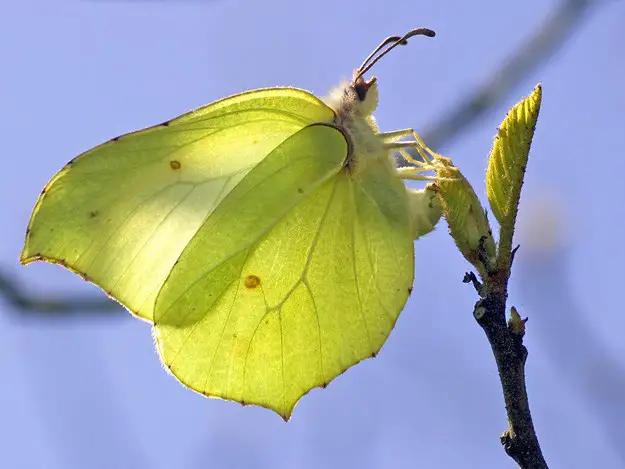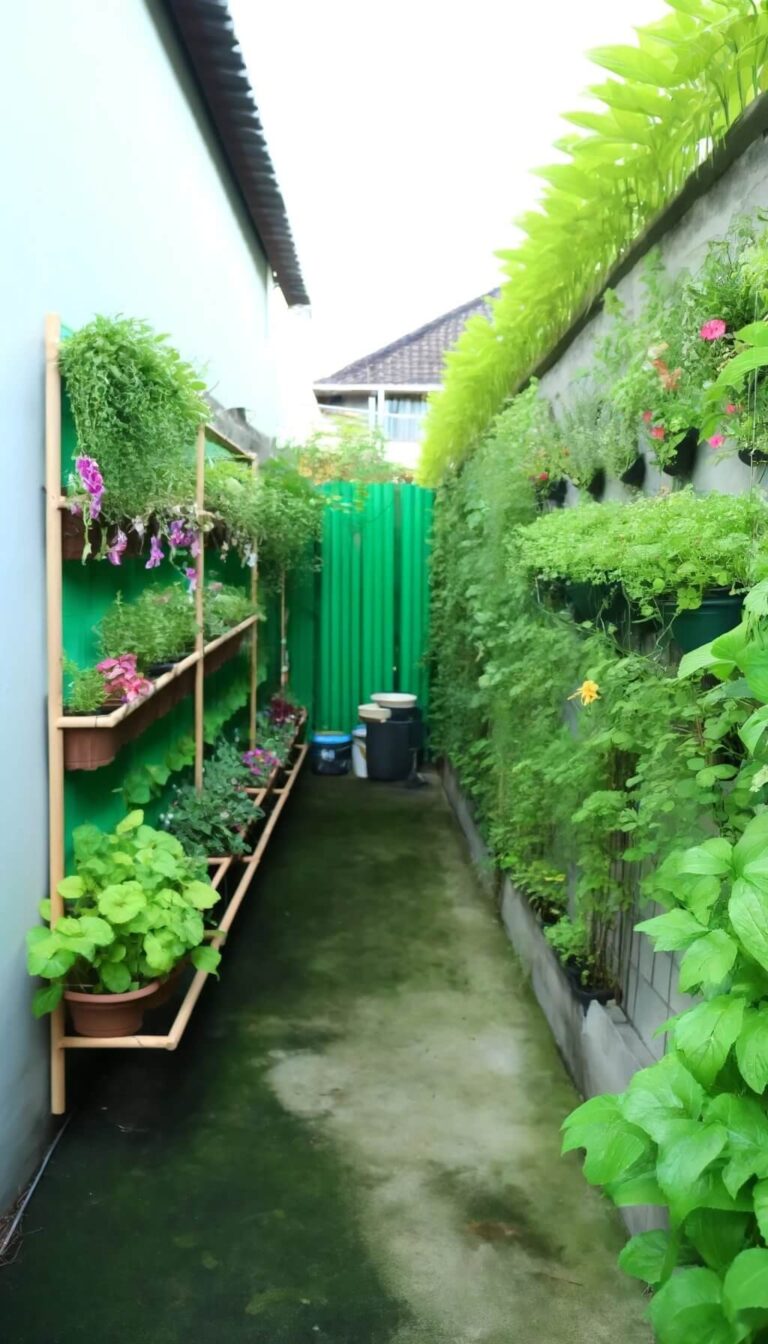40+ Beautiful Flowering Succulents & Plant Identification
Flowering succulents are a great way to bring some joy and relaxation into your life, even if you live in arid areas. Not only do they require less water than traditional flowering plants, but they’re also low maintenance and can thrive indoors or outdoors. Whether you’re looking to add some color and vibrancy to your garden or simply want to brighten up a room with some beautiful blooms, there are many options to choose from.
Some popular flowering succulents include Aloe Vera, Carrion Cactus, Christmas Cactus, Conophytum Calculus, Crassula ‘Springtime’, Crown of Thorns, Desert Rose, Donkey’s Tail, Dwarf Chin Cactus, Easter Cactus, Echeveria ‘Afterglow’, Echeveria ‘Black Knight’, and many others. These plants are not only easy to care for but also offer a range of benefits, from reducing stress and anxiety to purifying the air and improving your mood.
If you’re looking to get started with flowering succulents, here is an extensive list of options to consider: Aloe Vera, Carrion Cactus (Orbea variegata, Starfish Cactus), Christmas Cactus (Schlumbergera), Conophytum Calculus (Marble Buttons), Crassula ‘Springtime’, Crown of Thorns (Euphorbia Milii), Desert Rose (Adenium obesum), Donkey’s Tail (burro’s tail, Sedum morganianum), Dwarf Chin Cactus (Gymnocalycium baldianum), Easter Cactus (Rhipsalidopsis gaertneri), Echeveria ‘Afterglow’, Echeveria ‘Black Knight’, Echeveria ‘Blue Prince’, Echeveria ‘Doris Taylor’ (Woolly Rose), Sempervivum arachnoideum ‘Emily’ (Emily Cobweb Houseleek), Florist Kalanchoe, Hedgehog Cactus (Echinocereus engelmannii), Hens and Chicks (Sempervivum tectorum), Ice plant (Delosperma), Jade Plant (Crassula ovata), Lifesaver Cactus (Huernia zebrina), Living Stone (Lithops Aizoaceae), Moon Cactus (Gymnocalycium mihanovichii), Moonstone Plant (Pachyphytum oviferum), Night-Blooming Cereus, Sedum sieboldii ‘October Daphne’, Orchid Cactus (Disocactus ackermannii), Echeveria ‘Painted Lady’ (Echeveria derenbergii), Parodia Herteri, Peanut Cactus (Echinopsis chamaecereus), Pincushion Cactus (Mammillaria spinosissima), Plush Plant (Echeveria Harmsii), Powder Puff Cactus (Mammillaria bocasana), Prickly Pear Cactus (Opuntia), Rock Purslane (Calandrinia grandiflora), Othonna capensis ‘Ruby Necklace’, Sedum, String of Pearls (Curio rowleyanus), Graptopetalum ‘Superbum’, Tacitus Bellus (Graptopetalum bellus)
Aloe Vera
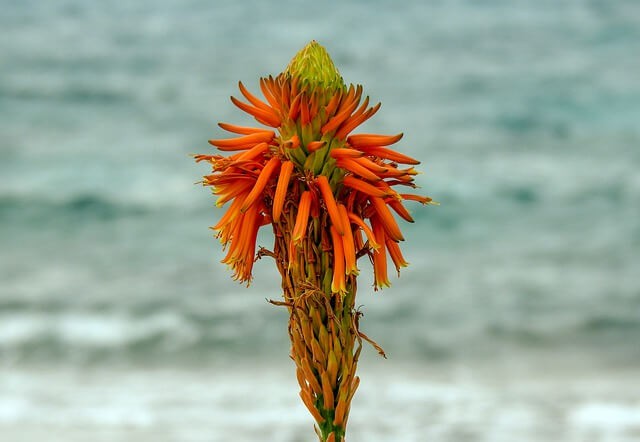
The sight of an aloe vera producing vibrant flowers can be astonishing, especially if you’re familiar with its typical thorny appearance. When given the right conditions, such as direct sunlight, this versatile plant can transform your outdoor space into a picturesque haven that’s hard to resist. In particular, zones nine through 11 prove ideal for growing aloe vera, as it thrives in well-drained soil and moderate watering.
But aloe vera’s uses don’t stop at mere aesthetics; its juice has been used for centuries as a natural remedy for minor injuries like cuts and burns. Its hardy nature and low-maintenance requirements also make it an excellent choice for novice indoor gardeners, perfect for those looking to dip their toes into the world of plant parenthood.
Carrion Cactus (Orbea variegata, Starfish Cactus)
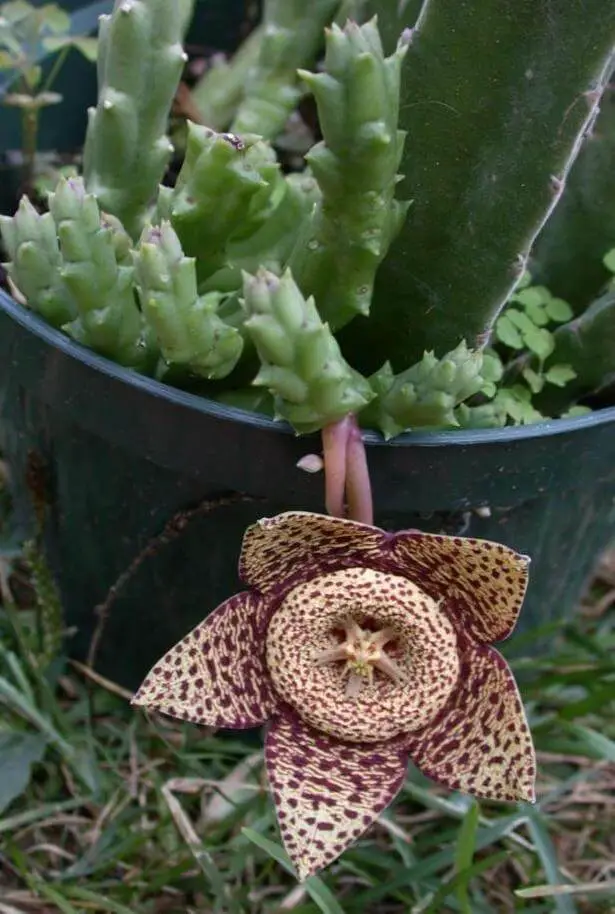
While the Carrion Cactus may not be the most conventional beauty, its unique features make it a fascinating addition to any garden. One of the plant’s defining characteristics is its ability to produce stems with no leaves at all, which sets it apart from other species. The real showstopper, however, are the flowers that bloom on these stems, emitting a distinctive scent reminiscent of carrion. This aroma isn’t just attractive to humans – birds and flies are also drawn to its pungent perfume.
To cultivate this unusual plant successfully, it’s essential to provide well-draining soil, whether growing it indoors or outdoors in arid conditions. Additionally, ensure the plant receives bright but indirect sunlight to thrive.
Christmas Cactus (Schlumbergera)
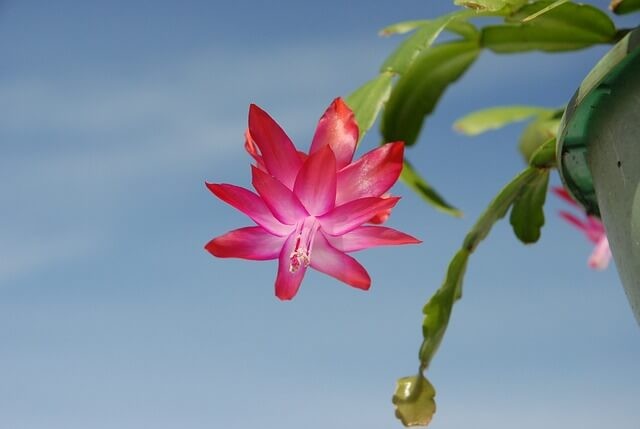
For a garden that remains stunning throughout the year, consider planting Christmas cactus. These succulents have a remarkable ability to bloom multiple times annually, ensuring your outdoor space stays vibrant and lively. In fact, Christmas cactus is known to produce flowers from October to March, making it an excellent choice for holiday decorating.
Not only do they provide a burst of color with their white, red, or yellow blooms, but they also stay in season long enough to be gifted to loved ones during the festive period. To keep them thriving, Christmas cactus prefers well-draining sandy soil and a touch of humidity, making it an ideal addition to any garden.
Conophytum Calculus (Marble Buttons)
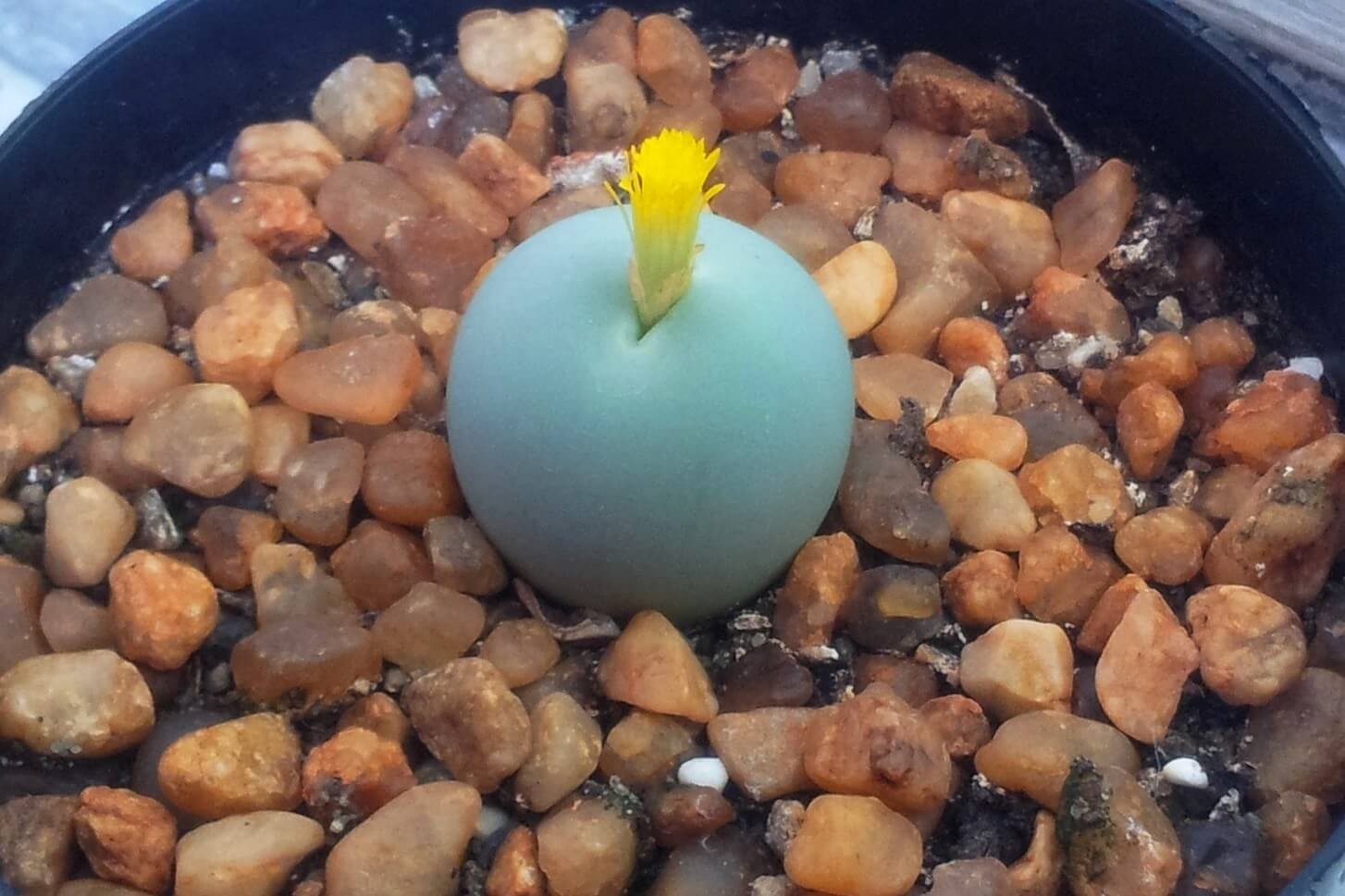
The Conophytum cactus, also known as Marble Buttons, boasts a striking appearance that is simply mesmerizing. One of the most distinctive features of this plant is its unique leaf structure, which resembles marble and gives it a smooth, chalky texture. As these leaves grow together, they form a spherical shape, adding to the overall visual appeal. But that’s not all – Marble Buttons are also known for their vibrant autumn blooms.
During this time, they produce fragrant flowers with a clove-like scent that fills the air, creating a truly enchanting atmosphere. And if you’re lucky enough to catch them in bloom, you’ll be treated to dark orange nocturnal flowers that are sure to captivate your senses.
Crassula ‘Springtime’
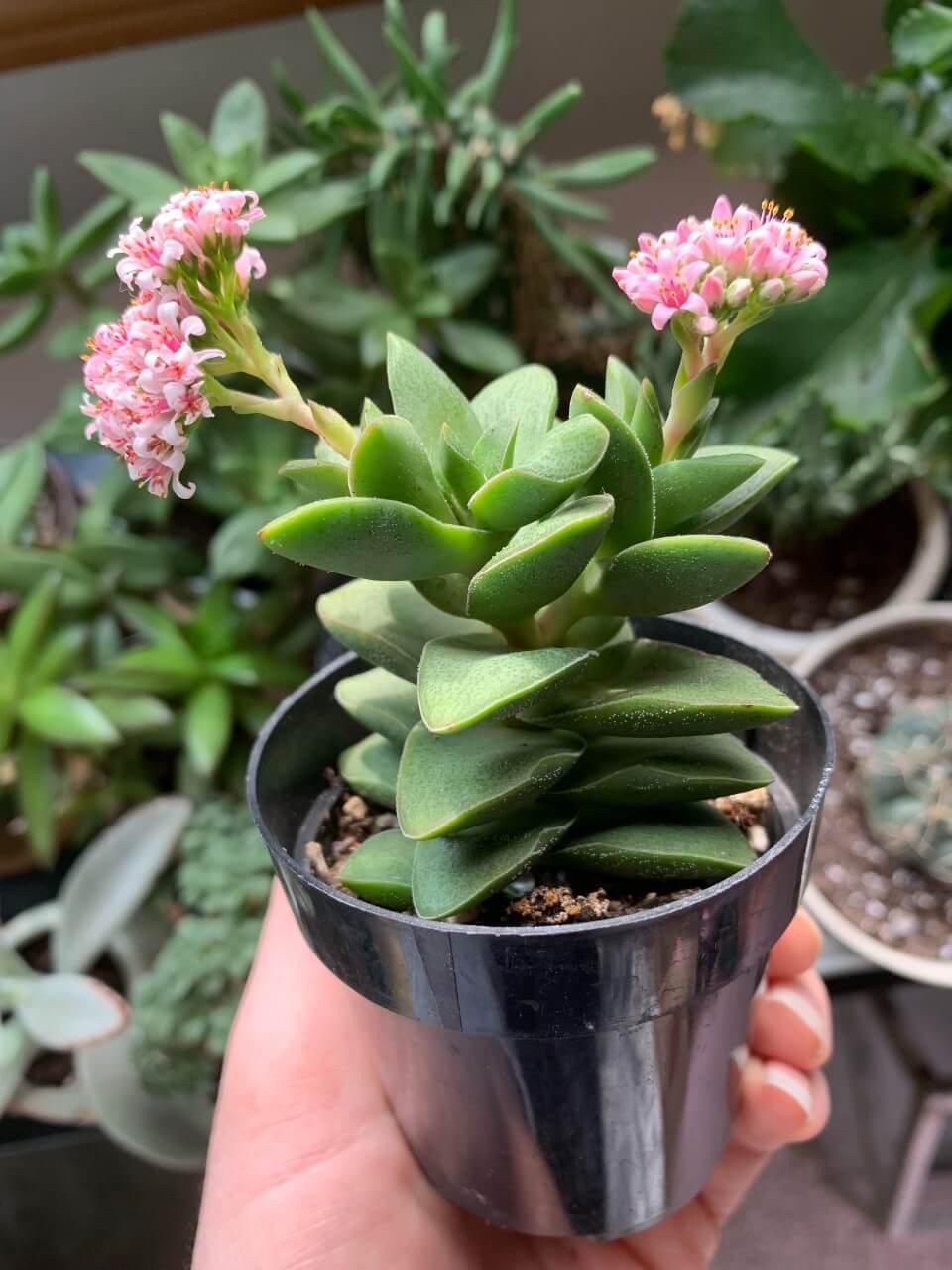
Transform your garden into a vibrant oasis with the charming Crassula Springtime, which thrives during late winter and early spring. This petite plant boasts an array of delicate flowers that pack a surprising punch. The sweet-scented blooms are not only irresistible to humans but also serve as a haven for bees and butterflies, drawing them in with their irresistible charm.
Crown of Thorns (Euphorbia Milii)
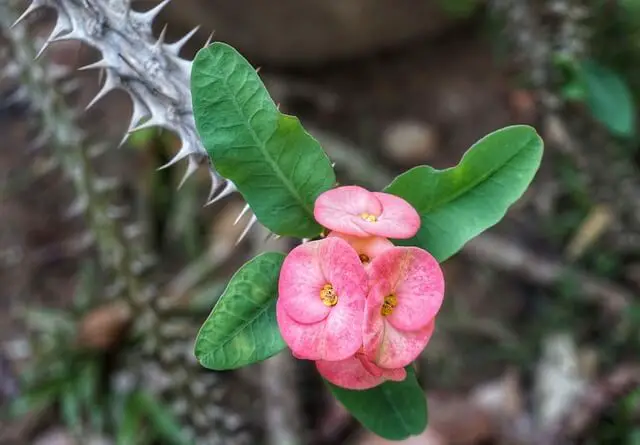
Behind the prickly exterior of the Crown of Thorns, lies a treasure trove of beauty waiting to be discovered. The vibrant red flowers that burst forth from this cactus are a sight to behold, making it an irresistible addition to any garden or indoor space. When placed in a spot with filtered sunlight, the Crown of Thorns will thrive and add a touch of elegance to your surroundings. Its versatility also makes it an excellent choice as a houseplant.
What’s more, this succulent is a low-maintenance gem that only demands occasional watering and well-draining topsoil to keep it happy.
Desert Rose (Adenium obesum)
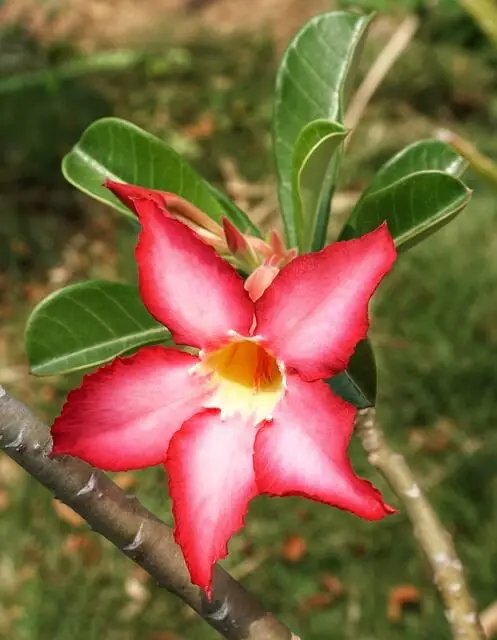
Desert roses are a popular choice for garden enthusiasts, offering a unique combination of beauty and adaptability. One of their most striking features is the thick, robust trunk that makes them an ideal candidate for bonsai displays. When grown in cooler climates, desert roses typically produce vibrant blooms in the spring and summer months.
However, those fortunate enough to cultivate them in warmer environments can enjoy a year-round display of stunning flowers in shades of red, pink, or white. What’s more, these succulents are surprisingly compact, reaching heights of only up to 10 feet, making them perfect for container gardening or small spaces. With their low-maintenance requirements and versatility, it’s no wonder why desert roses have become a favorite among gardeners.
Donkey’s Tail (burro’s tail, Sedum morganianum)
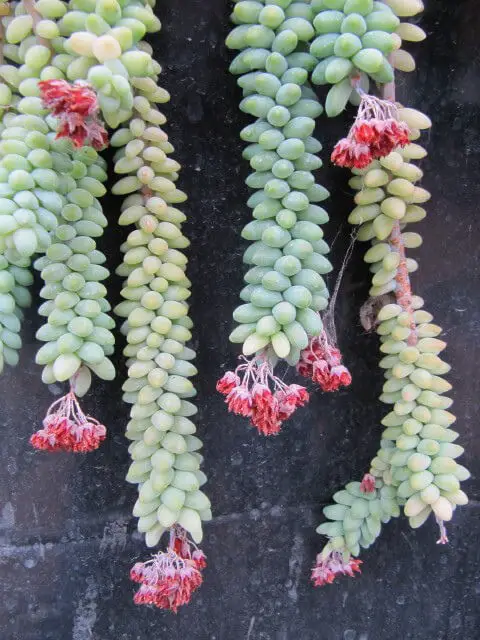
One succulent variety that’s relatively simple to cultivate is Donkey’s Tail. Its teardrop-shaped leaves and trailing stems make it an ideal choice for adding a touch of elegance to your garden. When these plants do bloom, they produce clusters of tiny red flowers nestled within their bulbous leaves. However, it’s essential to keep in mind that only mature Donkey’s Tails will flower, which means you’ll need to wait patiently for around four to six years before witnessing this beautiful display.
Dwarf Chin Cactus (Gymnocalycium baldianum)
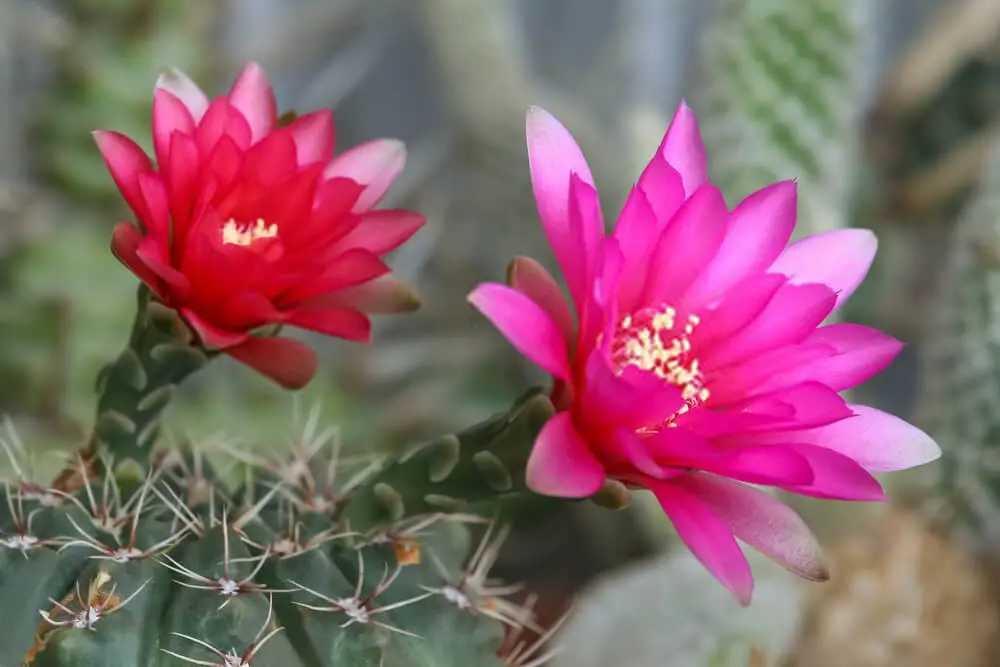
Dwarf chin cactus plants boast diminutive stature and flat, disc-like stems. Characterized by bristle-like radial spines, these succulents feature broad ribs that add to their unique charm. As the seasons change, Dwarf chin cacti reward gardeners with an array of colorful blooms, including vibrant orange, pure white, soft pink, and striking pinkish-purple hues, typically appearing in early summer.
Easter Cactus (Rhipsalidopsis gaertneri)
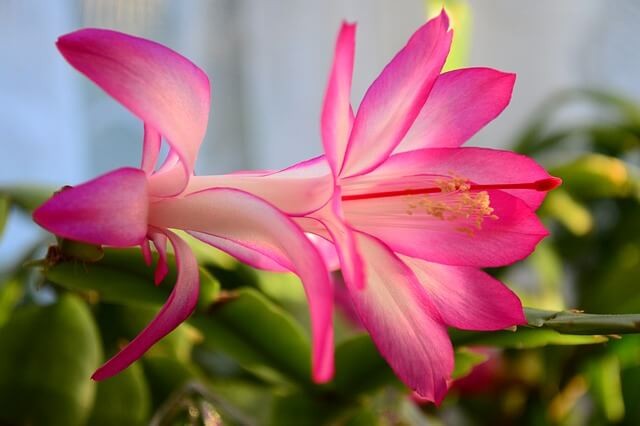
Easter cacti are renowned for their seasonal blooming, which coincides with the festive period of Easter, providing a stunning springtime display. One of the most straightforward succulent species to cultivate, the Easter cactus thrives when its natural environment is emulated. Unlike many other succulents that require arid desert conditions, this plant has unique needs: it demands more moisture and less intense light.
Echeveria ‘Afterglow’
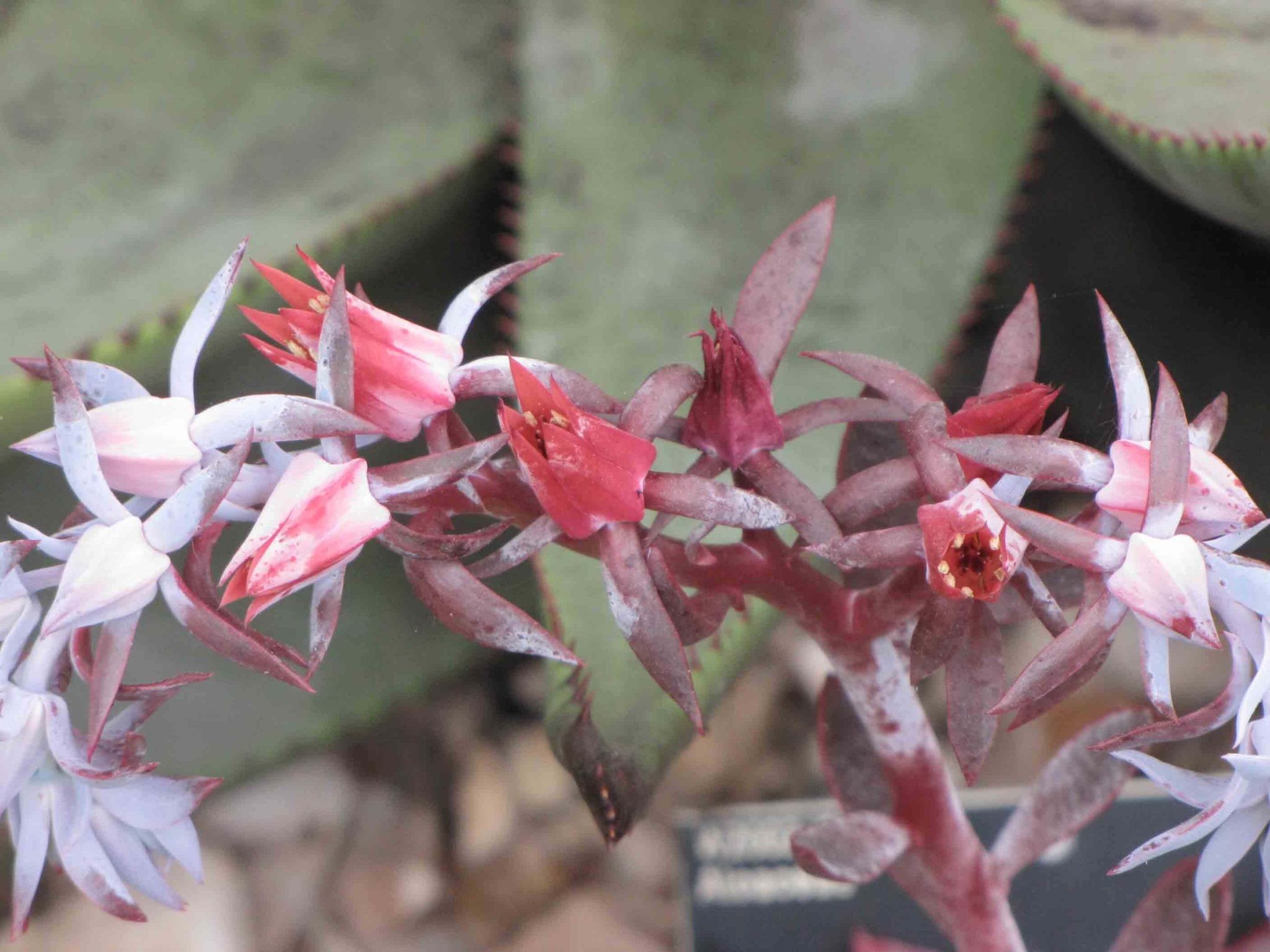
The Echeveria succulent family boasts a stunning member known as Afterglow, which lives up to its name by radiating a captivating glow in your garden. The leaves of this variety boast a striking resemblance to those of lavender plants, with edges that take on a beautiful pink hue. But the visual allure doesn’t stop at the foliage – the reddish flower blooms that emerge are equally breathtaking.
When grown in full sun, Afterglow’s color palette truly comes alive, offering a kaleidoscope of hues that will leave you mesmerized.
Echeveria ‘Black Knight’
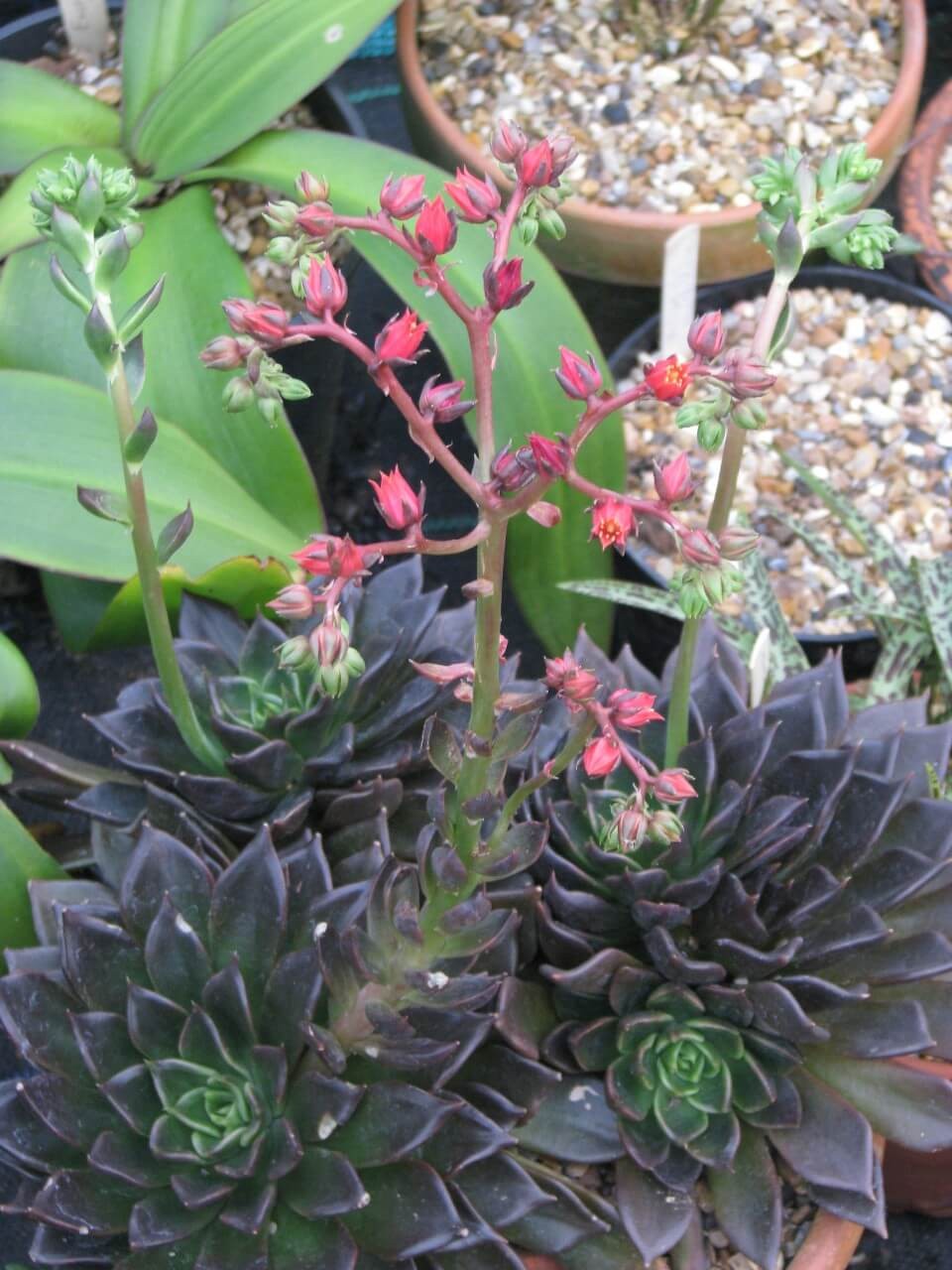
The Black Knight echeveria family is a captivating addition to any garden, boasting a striking deep black coloration. As this succulent takes hold in your outdoor space, you can expect an explosion of beautiful blooms come late summer and fall. The visual appeal begins with the unique, eye-catching shape of their black sepals, which serve as the perfect backdrop for the vibrant, star-shaped flowers that emerge within.
These radiant red blooms are sure to lift your spirits and add a pop of color to your garden landscape.
Echeveria ‘Blue Prince’
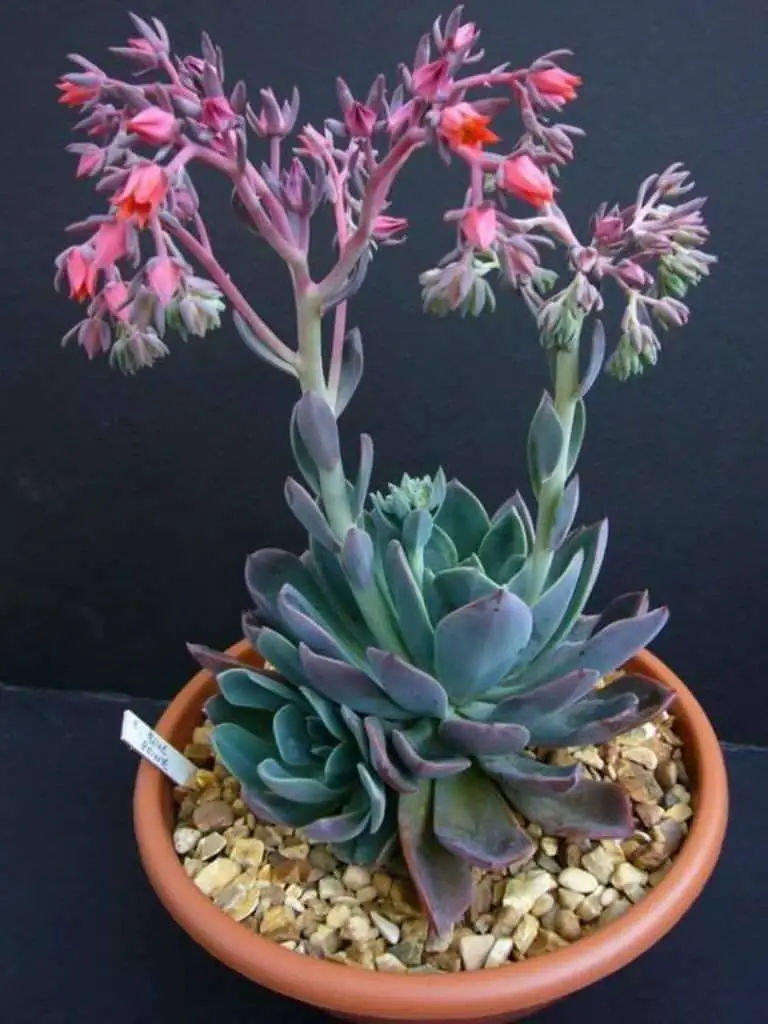
As you gaze upon the Blue Prince’s majesty, consider basking it in the radiant warmth of the sun. The true essence of this stunning plant begins with its leaves, which are adorned with a fine layer of powdery farina. As the sunlight catches them just so, the blue-green rosette takes on a pinkish hue, as if infused with the gentle glow of dawn. Meanwhile, the flowers unfurl in shades of red to pink, their star-shaped petals unfolding like tiny works of art.
It’s a symphony of color and texture that is simply breathtaking.
Echeveria ‘Doris Taylor’ (Woolly Rose)
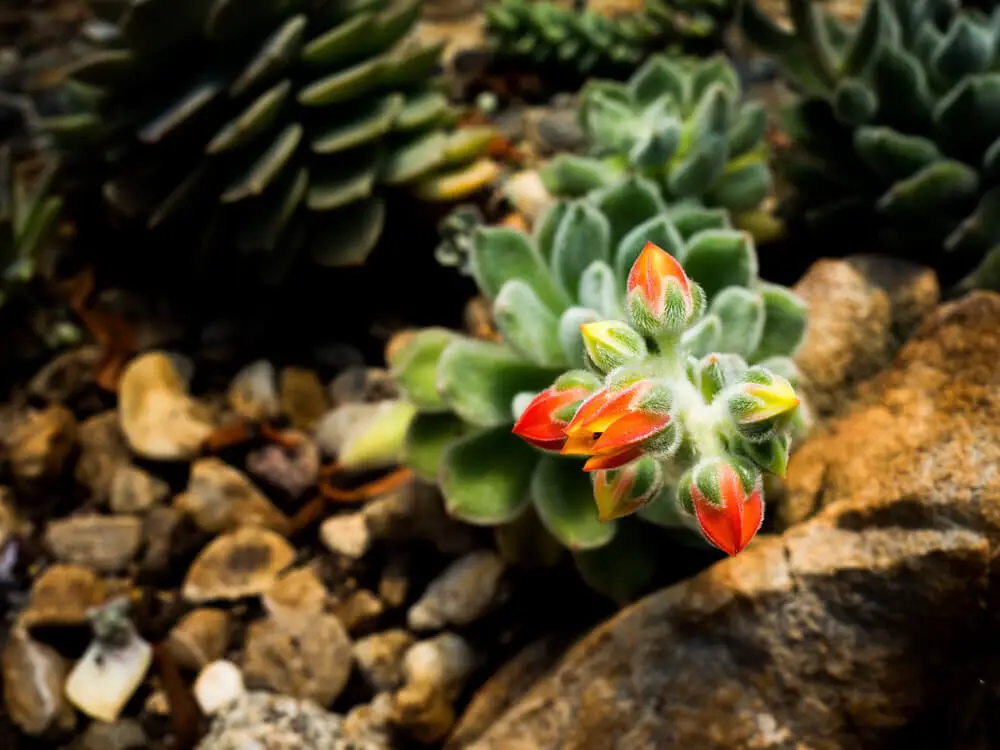
Doris Taylor, a hybrid echeveria variety, boasts striking silver-green leaves with a unique fuzziness that gives them a velvety texture. The leaves’ peculiar appearance is further enhanced when they respond to temperature fluctuations by developing a reddish hue. As one of the flowering succulents, Doris Taylor’s most notable feature is its vibrant yellow blooms, which add a pop of color to any setting.
Sempervivum arachnoideum ‘Emily’ (Emily Cobweb Houseleek)
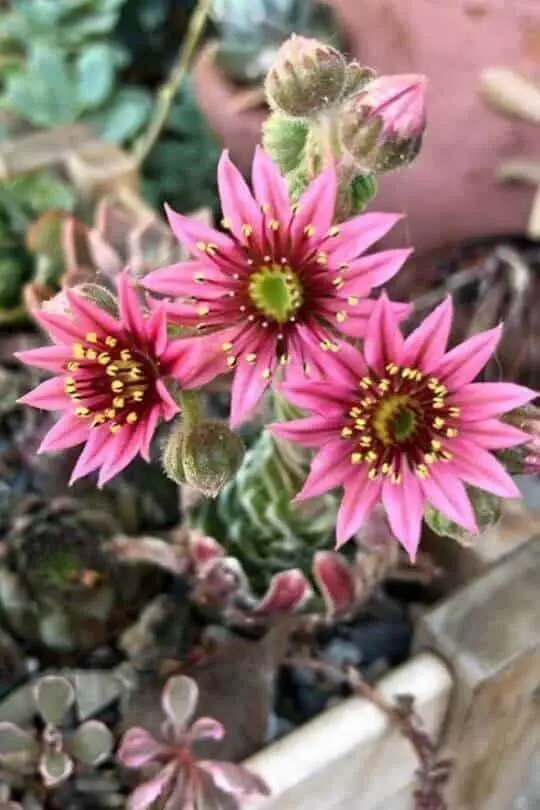
Emily Cobweb Houseleek, a striking member of the hen and chick family, boasts a distinctive appearance that sets it apart from other succulents. Its leaves display a striking red and green coloration, further embellished by intricate cilia resembling spider webs. The name ‘cobweb’ is aptly derived from this web-like substance that covers its foliage. For gardeners, Emily Cobweb Houseleek’s unique appearance makes it the most coveted species to cultivate.
Beyond its striking leaves, this succulent also produces charming pink flowers that take on a star-shaped form. Moreover, Emily Cobweb Houseleek is an easy-going plant that thrives in both indoor and outdoor environments. Its natural ability to survive in cold climates year-round makes it an attractive option for those seeking low-maintenance yet visually appealing additions to their gardens or homes.
Florist Kalanchoe (Conophytum calculus)
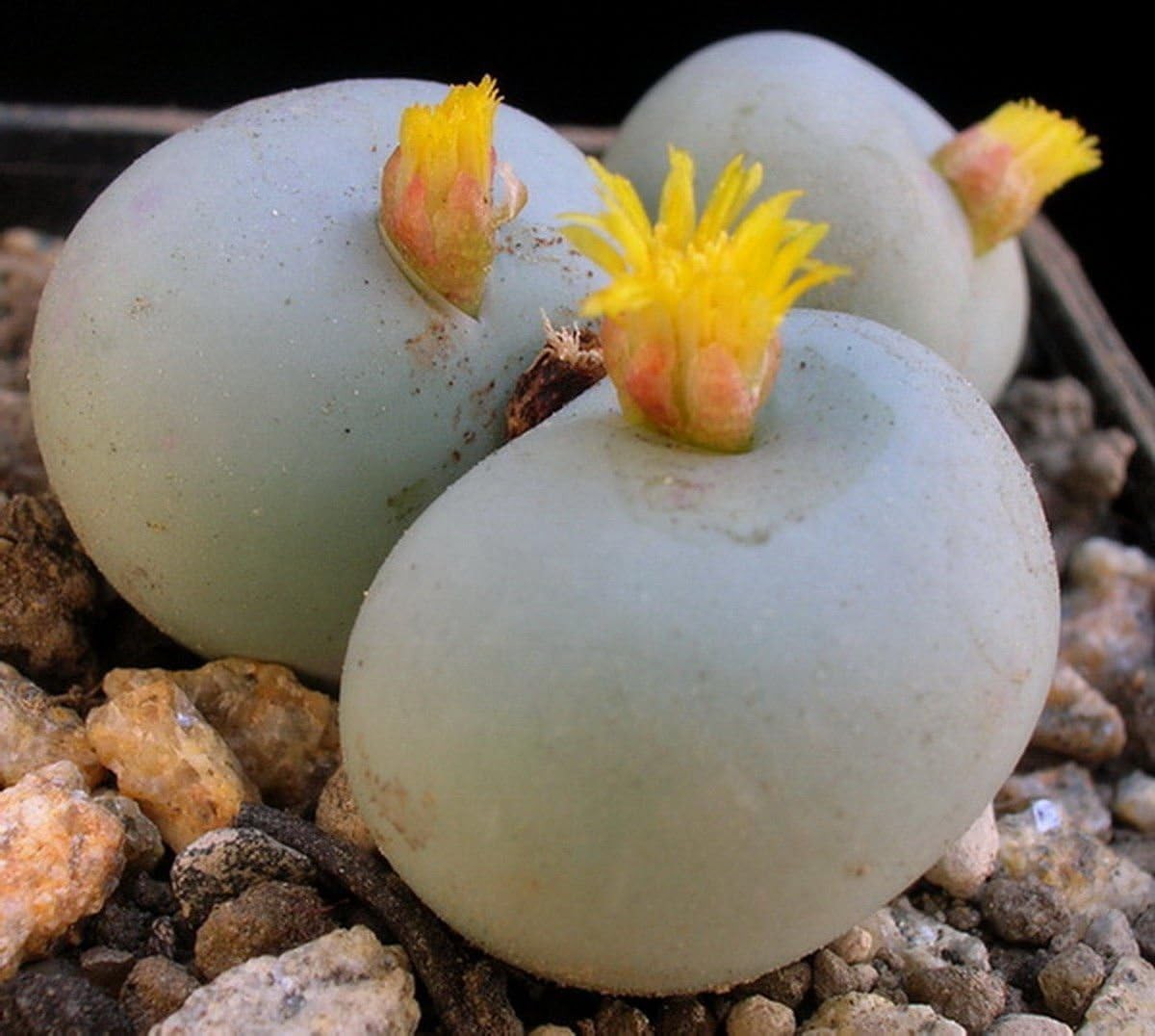
Kalanchoe, an evergreen succulent, is renowned for its low maintenance requirements and striking beauty. This versatile plant comes in a range of sizes and vibrant flower colors that add a pop of color to any room. Its lush green foliage perfectly complements the bright blooms, making it a stunning addition to your home decor. As a houseplant, Kalanchoe thrives when placed near a sunny window, allowing it to absorb sufficient sunlight necessary for its flowers to bloom.
However, it’s essential to ensure the plant remains dry, as excess moisture can hinder its growth. Additionally, homeowners with pets should exercise caution, as this succulent may not be pet-friendly.
Hedgehog Cactus (Echinocereus engelmannii)
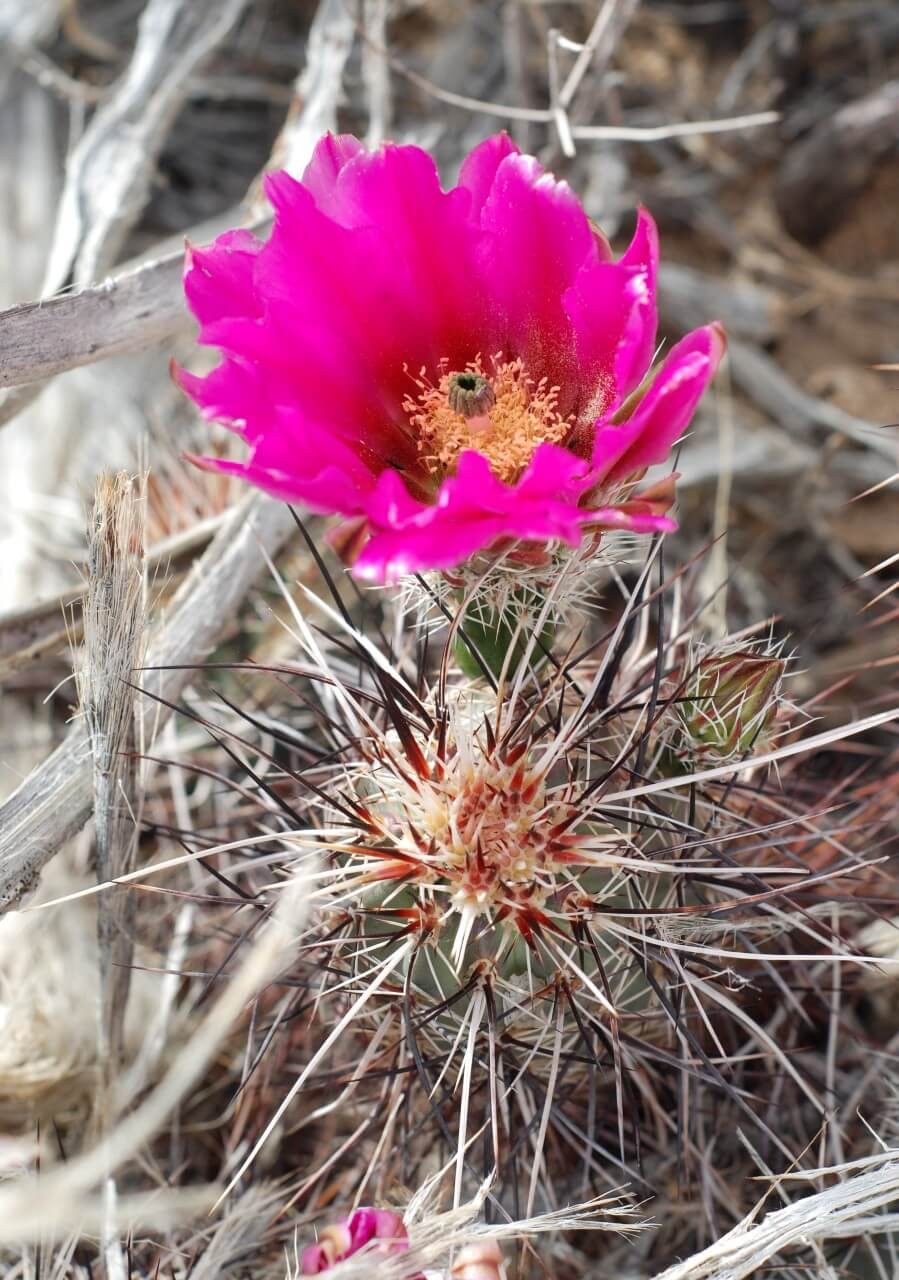
At first glance, the hedgehog cactus may be mistaken for artificial flowers found in craft stores. The primary distinction lies in its authenticity – these are real plants. However, without witnessing their bloom, it’s unlikely to regard them as one of the finest succulent species. It’s only when summer arrives that this small plant transforms into stunning pink blooms, revealing its true beauty.
Hens and Chicks (Sempervivum tectorum)
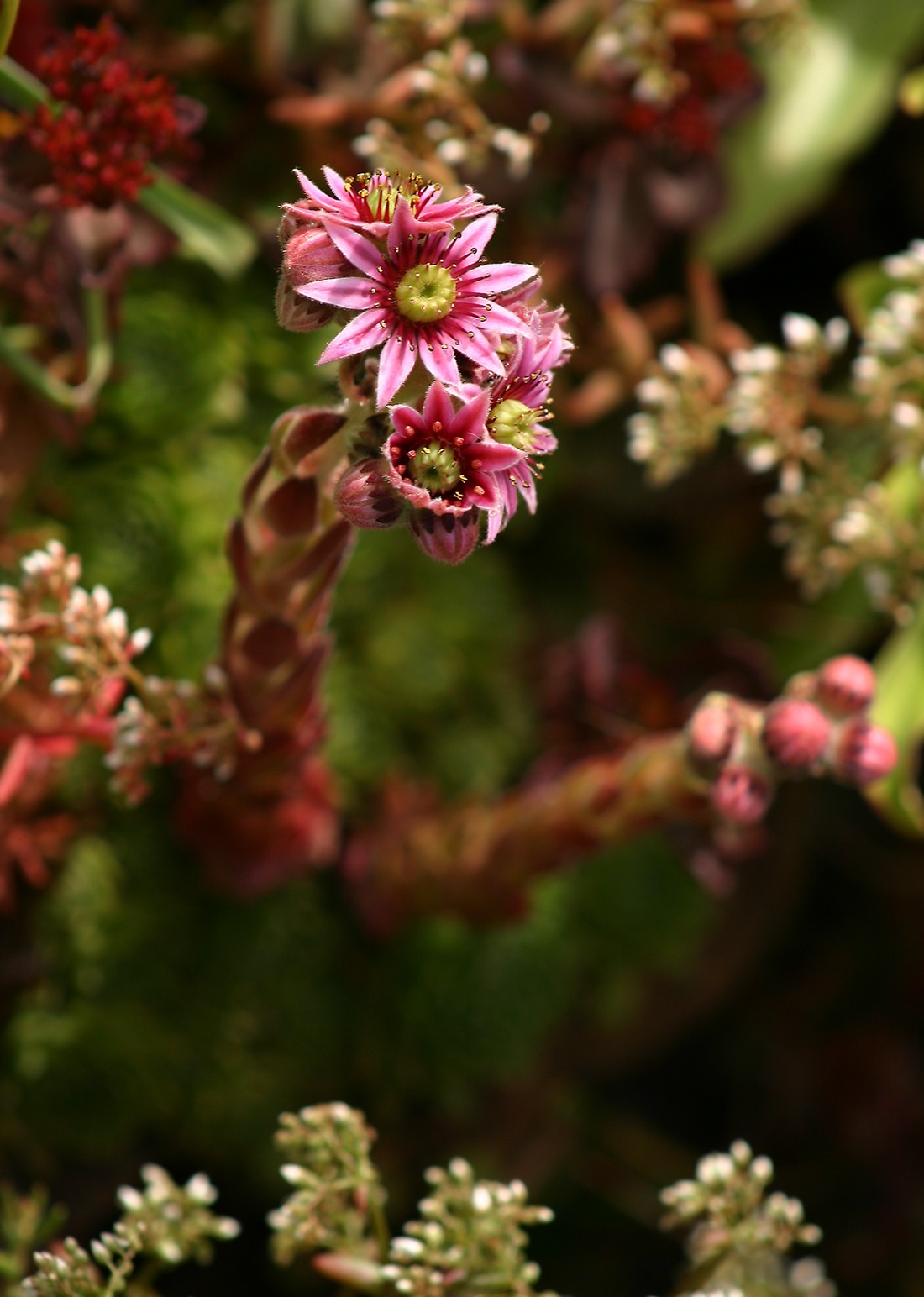
Hens and Chicks succulents, with their characteristic cobweb-like coverings, boast a unique charm. One of their most striking features is the vibrant magenta pink blooms they produce, which can adorn your garden for weeks on end. When grown indoors or outdoors in conditions that are either cool or hot, this adaptable plant thrives. Its low-maintenance nature makes it an ideal choice for succulent enthusiasts, as long as the climate is suitable.
Whether brought indoors or left to shine outside, Hens and Chicks succulents can flourish with minimal care.
Ice plant (Delosperma)
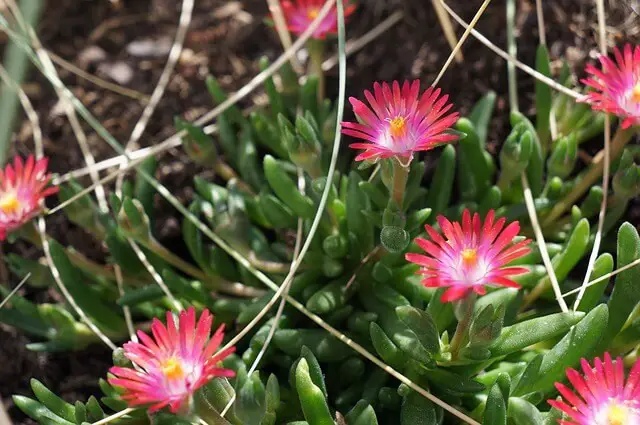
The distinctive appearance of the ice plant is characterized by its stacked leaves that form a layered structure, resembling a tower. Each leaf pair lies opposite one another, giving rise to this unique architectural feature. The crowning glory of the ice plant is its vibrant yellow flower clusters that appear to sprout from atop this leafy tower.
For gardeners fortunate enough to have ice plants in their plots, the reward comes in the form of stunning floral displays that persist throughout summer and into fall. To cultivate these beautiful blooms, ice plants require well-drained soil and sufficient sunlight.
Jade Plant (Crassula ovata)
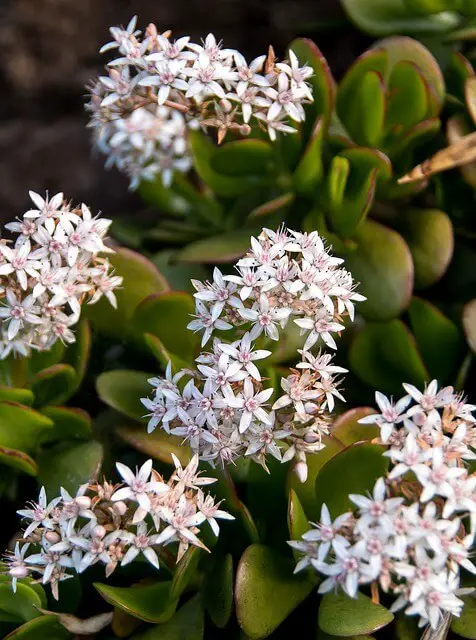
The Jade succulent stands out for its vibrant blooms, featuring star-shaped flowers in a palette of purple, pink, and white hues. Its remarkable ability to thrive in dry environments is thanks to its natural drought tolerance, rendering watering and sunlight unnecessary. As a result, the Jade plant has earned its place as the most popular succulent among gardeners, who appreciate its low-maintenance requirements.
One of the Jade’s most striking features is its unique foliage, boasting a mesmerizing blue-green color scheme that shifts to maroon or burgundy at the tips. This succulent’s ease of growth makes it an excellent choice for beginners, although it does require some finesse when grown indoors.
Lifesaver Cactus (Huernia zebrina)
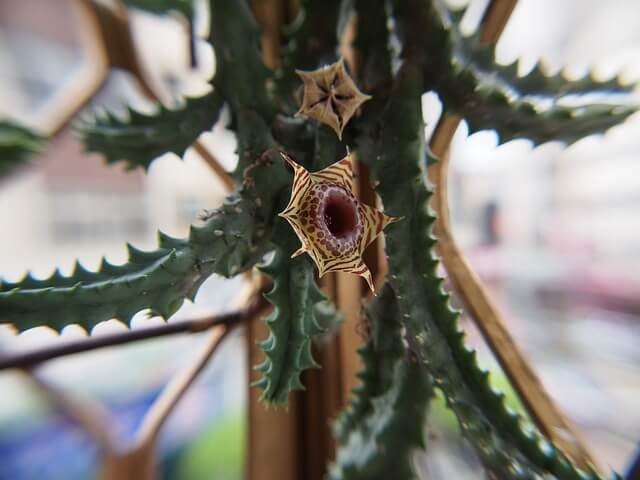
This enigmatic succulent boasts a striking zebra-striped appearance and a distinctive donut-shaped ring at its core. Although relatively rare, this unusual plant blooms in late summer, producing flowers with a burgundy and tan star pattern. The central feature of these blooms is often accompanied by a small grape-flavored ‘lifesaver’ shape. Both indoor and outdoor environments can support the growth of this succulent, as long as it’s protected from frost and drafts.
One notable characteristic is its ability to propagate easily by producing roots along its stem whenever it comes into contact with soil, making it simple to share or multiply.
Living Stone (Lithops Aizoaceae)
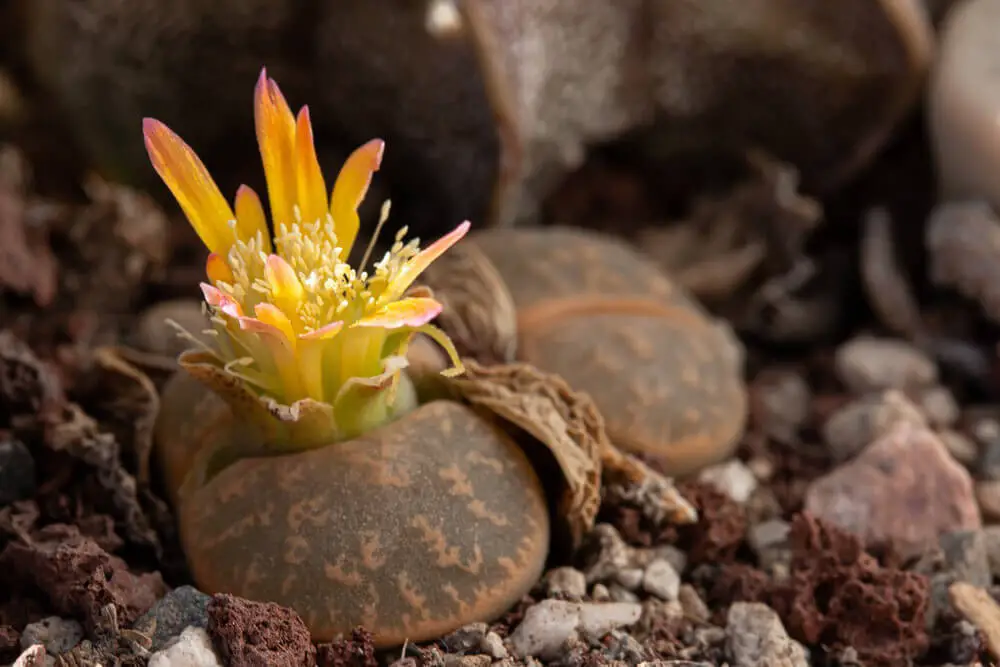
At first glance, Livingstone plants may be mistaken for stones due to their unique, stony appearance. This peculiar trait makes them stand out as one of the most intriguing plants you’ll ever encounter. One of the benefits of these plants is that they can thrive in even the smallest spaces, as long as they receive some sunny windowsill exposure.
As it turns out, Livingstone plants have a natural habit of dormancy during both summer and winter months.
During this time, they won’t require any watering. However, when spring and fall arrive, it’s essential to provide them with the right amount of moisture. With the proper conditions in place, these plants will surprise you with their daily-like flowers that bloom in the spring.
Moon Cactus (Gymnocalycium mihanovichii)
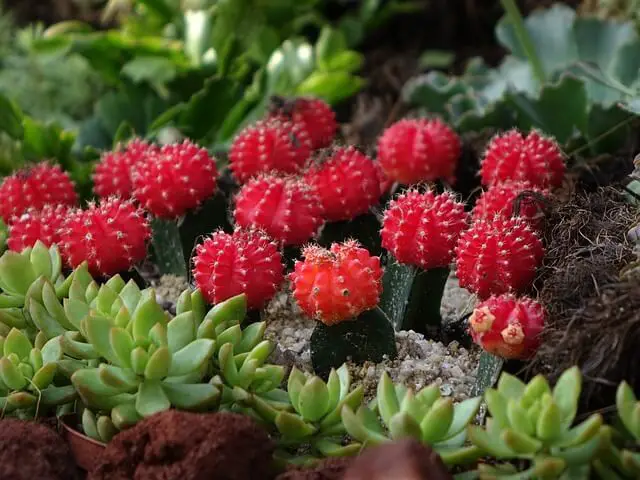
The moon cactus, a stunning succulent, brings vibrant yellow, pink, and orange blooms to your home when in flower. Its versatility shines through its varied sizes, colors, and shapes, allowing for an array of unique decorative options. A standout feature is its singular stalked growth pattern, topped with a striking bulbous head. For gardeners, the moon cactus’ low-maintenance nature is a significant draw – it thrives on minimal watering, making it ill-suited to overhydration.
Notably, this cactus has a relatively short lifespan, which is something to consider when deciding to bring one into your home.
Moonstone Plant (Pachyphytum oviferum)
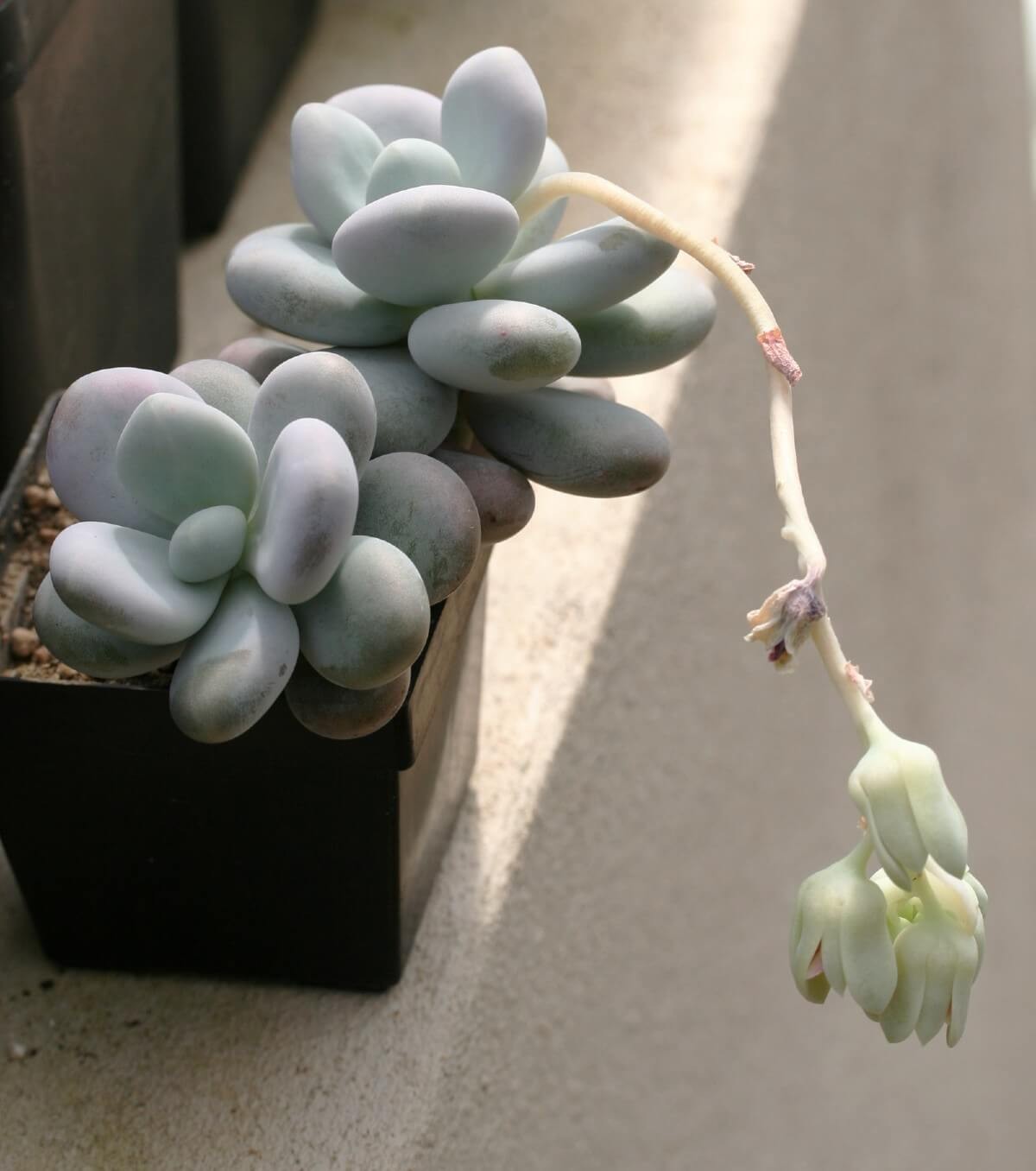
For those who have a weakness for foliage, moonstone is an ideal choice. This rosette succulent boasts rounded leaves that bear a striking resemblance to small stones. As spring arrives, moonstone truly shines by producing delicate flower spikes. The blossoms themselves emerge from slender stems, featuring a stunning combination of orange and white hues that create a breathtaking display.
Night-Blooming Cereus
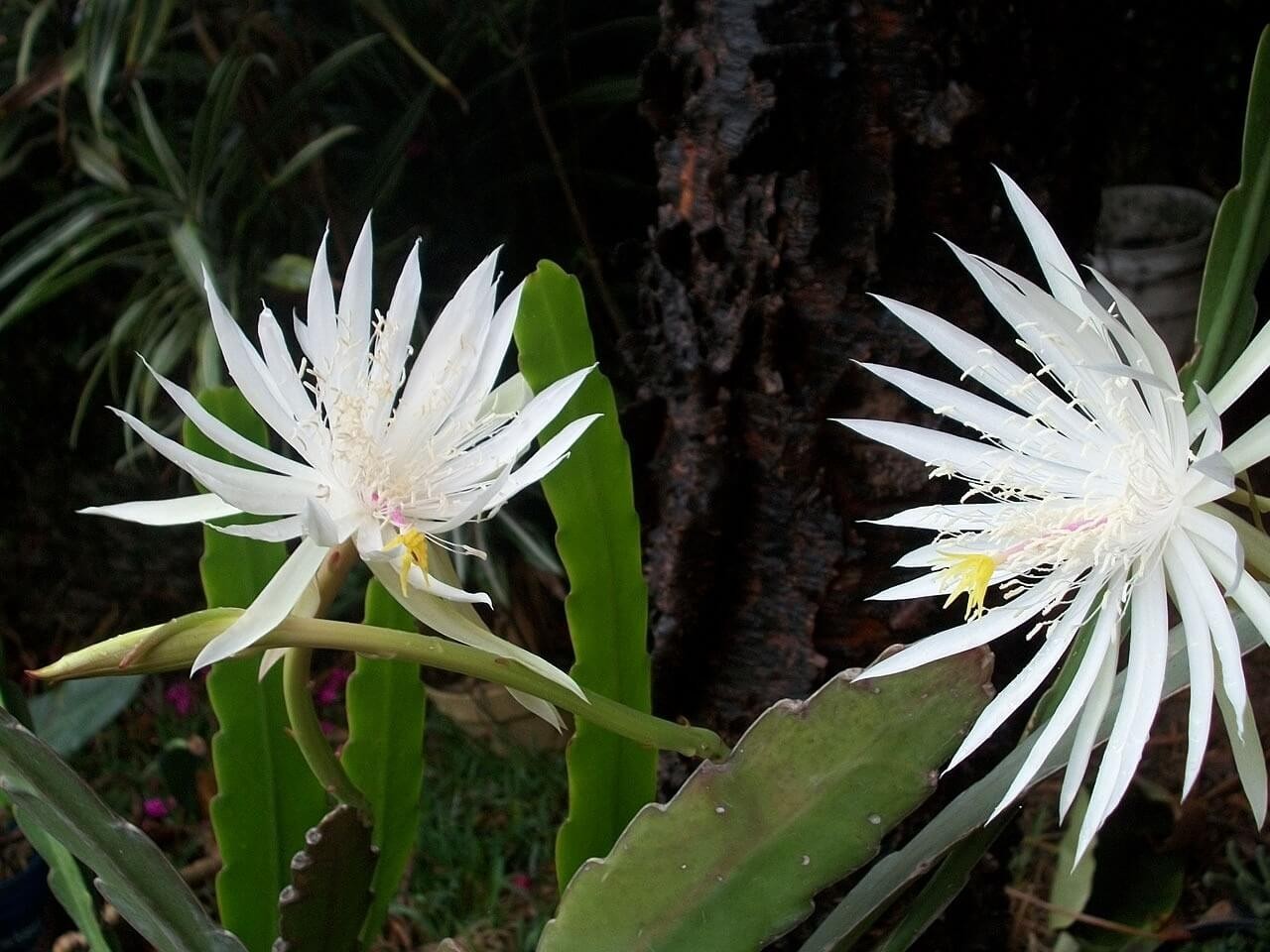
While its name implies a rarity, this plant’s blooming habits are indeed unique. Unpredictably, it unleashes a vibrant floral display under the cover of darkness, often when we’re fast asleep. For those who cherish these fleeting moments of beauty, it may be worth sacrificing a few hours of shut-eye to capture the spectacle on camera. The sheer abundance of white blooms that burst forth at night serves as a beacon of brightness in the otherwise darkened world.
Sedum sieboldii ‘October Daphne’
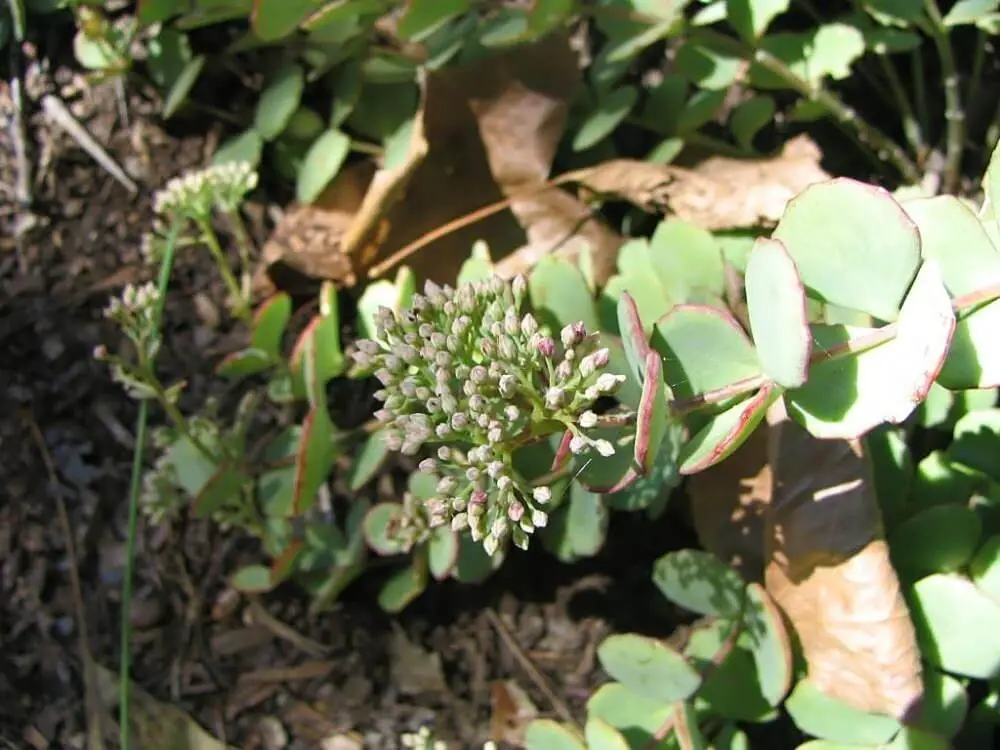
October Daphne, a stunning perennial succulent, steals the show with its vibrant greenish-blue foliage from the moment it emerges. But it’s not just its leaves that make it a standout – its bright, star-shaped flowers form clusters that extend right along the stems, creating a breathtaking display. Whether you’re looking to add some drama to your indoor or outdoor space, October Daphne is an excellent choice, provided you give it full sun and consistent moisture.
If you opt for indoor planting, be sure to water it more frequently to keep it happy.
Orchid Cactus (Disocactus ackermannii)
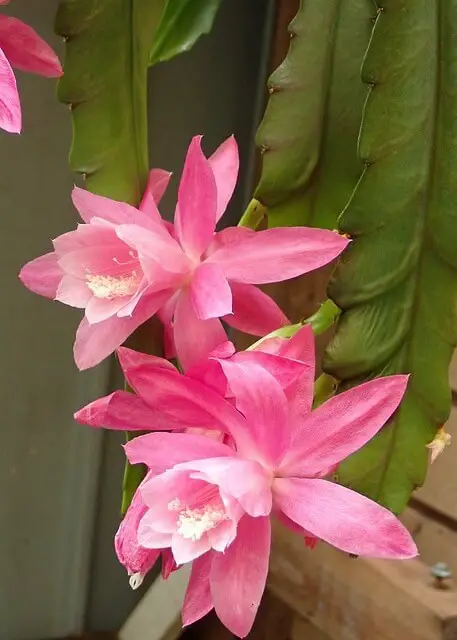
While orchid cacti don’t bloom frequently, the rare occasions when they do are truly breathtaking. In fact, these plants typically take two years to mature before producing any flowers, and even then, it’s a relatively infrequent occurrence – usually limited to just a few nights in a year. When they do bloom, however, it’s well worth the wait.
To coax your orchid cactus into its best form, be sure to provide it with adequate light and nutrients, as this will significantly enhance the display of showy flowers that form at the end of the plant’s stems. For an added touch of elegance, consider growing your orchid cactus in a hanging basket – the way the stems cascade down from the container creates a truly stunning visual effect.
Echeveria ‘Painted Lady’ (Echeveria derenbergii)
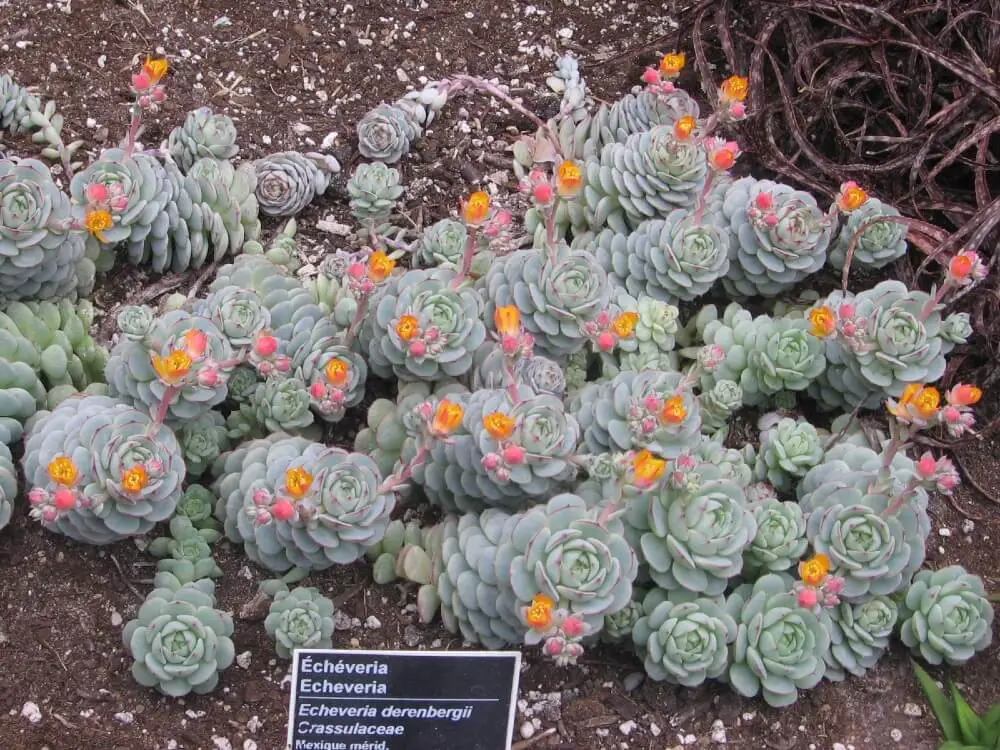
What initially catches the eye about these succulents is their delicate appearance, but it’s precisely this subtlety that makes them so captivating. Their evergreen foliage forms a compact rosette of silvery blue and green leaves with striking red margins, which provides a visually appealing contrast. As spring approaches, the plants transform into stunning displays of red, elongated stalks adorned with vibrant yellow-pink flowers featuring prominent red tips.
For those who eagerly anticipate the arrival of spring, the harmonious combination of verdant foliage and showy blooms serves as an intuitive indicator that the season is near. The succulents’ unique color palette ensures a unique and breathtaking aesthetic in your garden.
Parodia Herteri
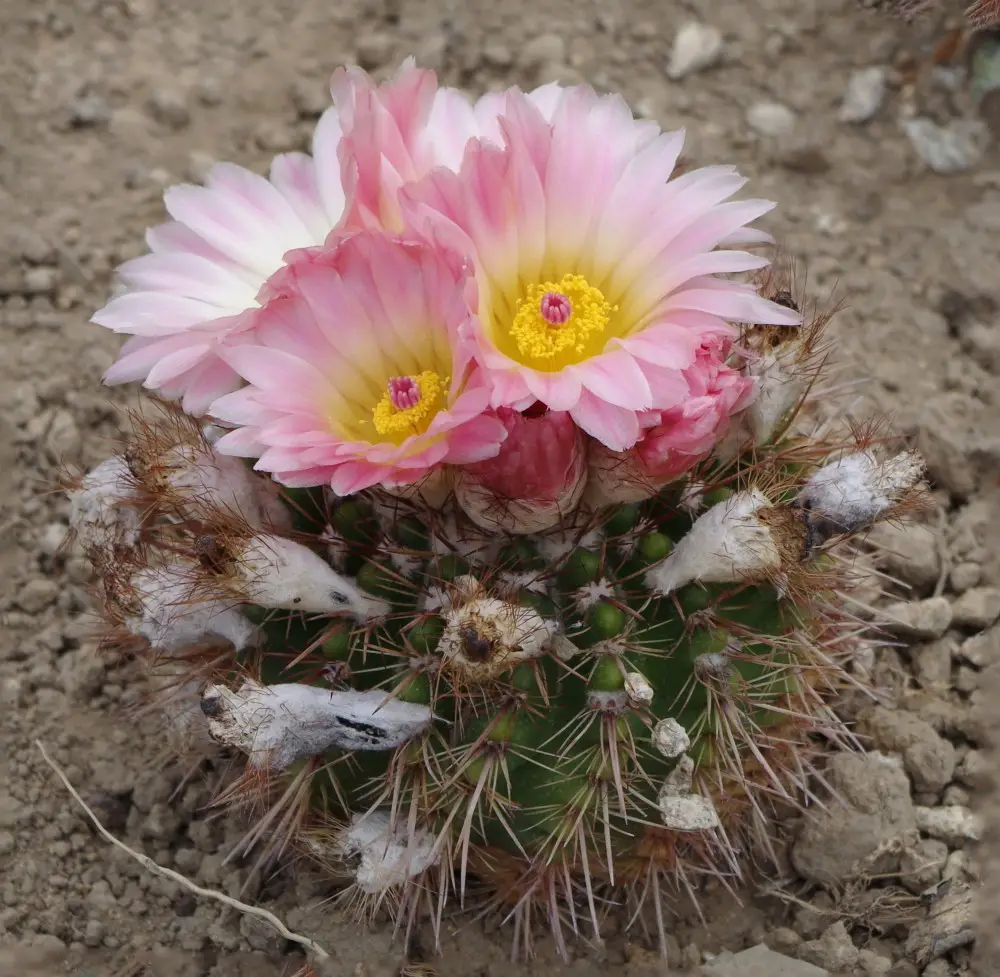
Wilhelm Herter, a renowned botanist, lends his name to the striking Parodia Herteri. This unique succulent is characterized by its singular stem, which takes on a spherical shape as it grows. Notably, this plant develops brown spines that mature into cylindrical structures over time. When in bloom, Parodia Herteri showcases vibrant pink flowers featuring a prominent yellow eye, typically during the summer months.
Boasting low-maintenance requirements, this succulent thrives in sunny windowsills, making it an ideal choice for indoor gardens.
Peanut Cactus (Echinopsis chamaecereus)
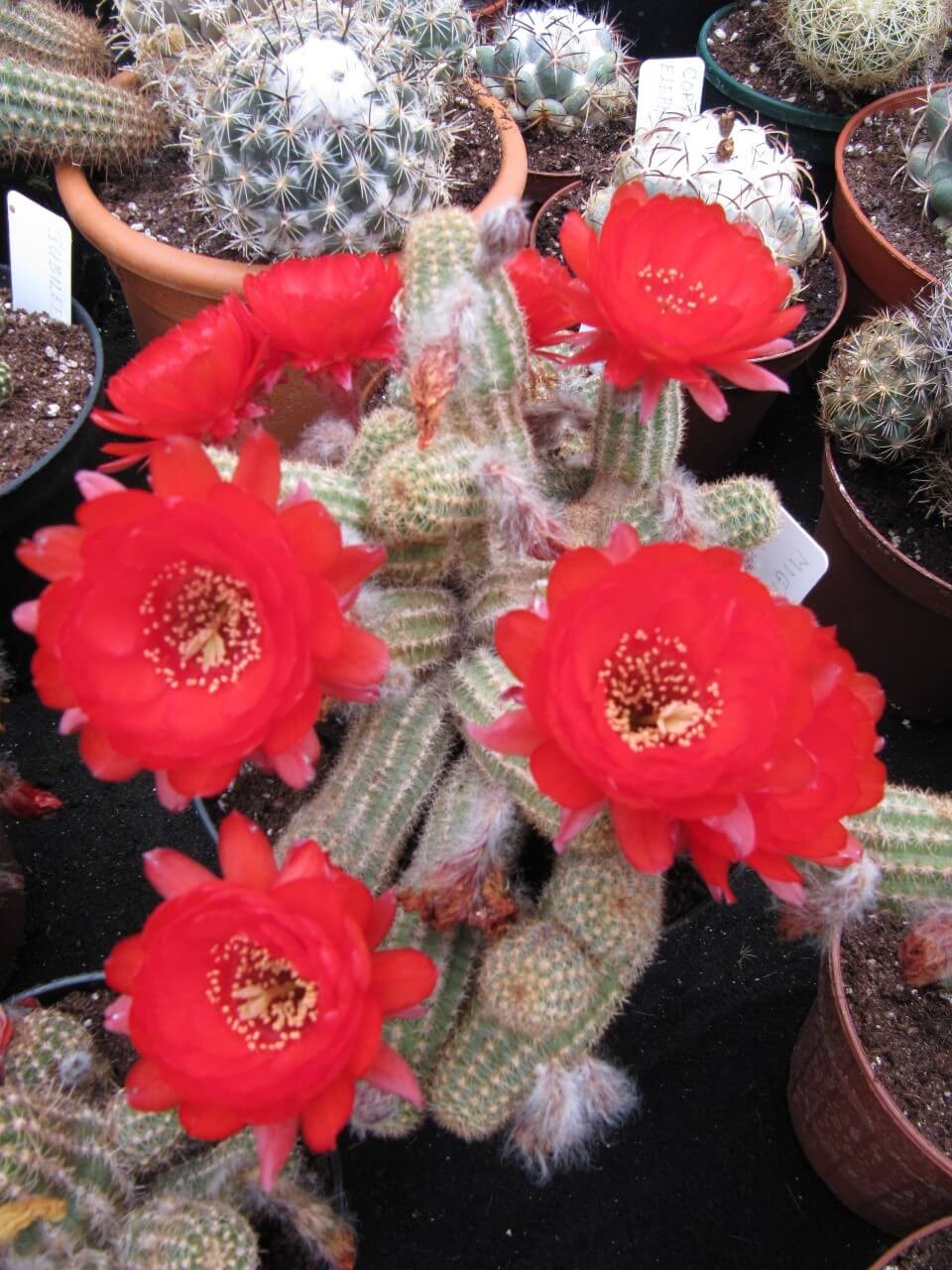
As spring arrives, your garden may suddenly be bustling with vibrant orange visitors courtesy of your peanut cactus. This unique plant produces thick, finger-like segments that take on a peanut-like shape, earning it its name. But what’s truly striking is the stunning display of large, reddish-orange flowers that bloom in a star pattern.
Peanut cactus thrives in hot environments with a touch of shade, and its origins can be traced back to mountainous regions.
One notable characteristic is their tendency to grow outwardly with shallow roots, allowing them to spread out and adapt to their surroundings.
Pincushion Cactus (Mammillaria spinosissima)
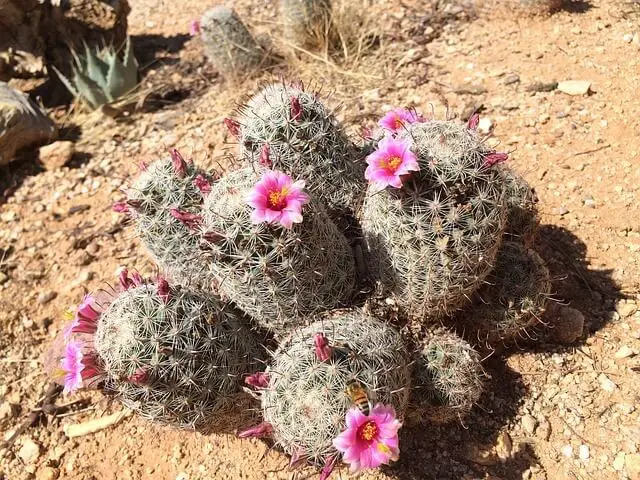
When given ideal conditions, this captivating plant quickly rewards you with an abundance of vibrant pink blooms. To encourage its flourishing, provide it with adequate watering and direct sunlight exposure. While it can adapt to dry periods, the pincushion cactus also proves remarkably easy-going, making it a fantastic choice for indoor enthusiasts seeking to expand their succulent collection.
Plush Plant (Echeveria Harmsii)
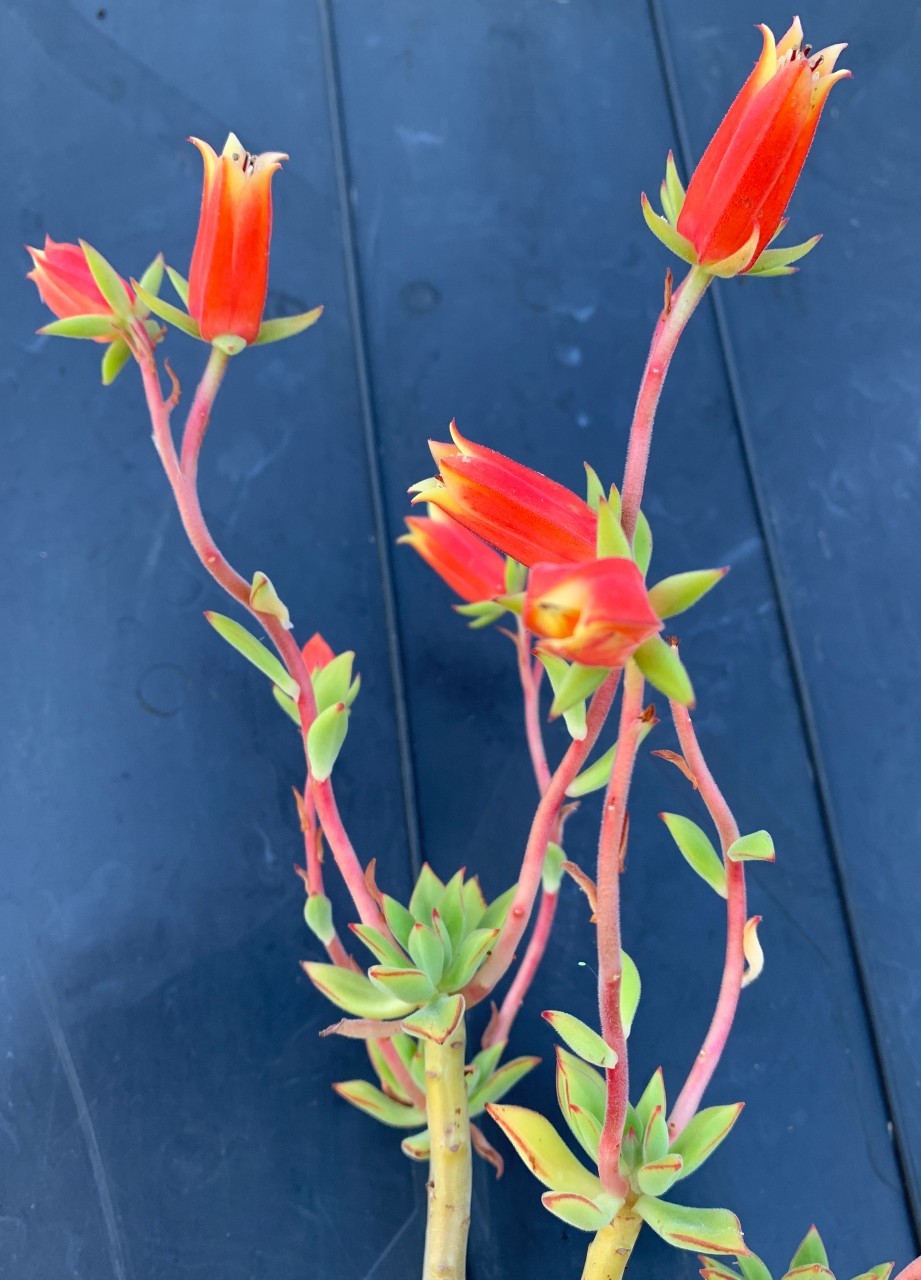
The Aloe aristata, also known as the woolly aloe, is easily identified by its soft, white hairs that glisten silver in sunlight. Its striking orange-yellow blooms are reminiscent of a sunset’s warm hues. This succulent thrives in containers or directly in the ground, provided you replicate its natural environment accurately. For optimal growth, it prefers warmer months and soil that’s completely dry to the touch.
Powder Puff Cactus (Mammillaria bocasana)
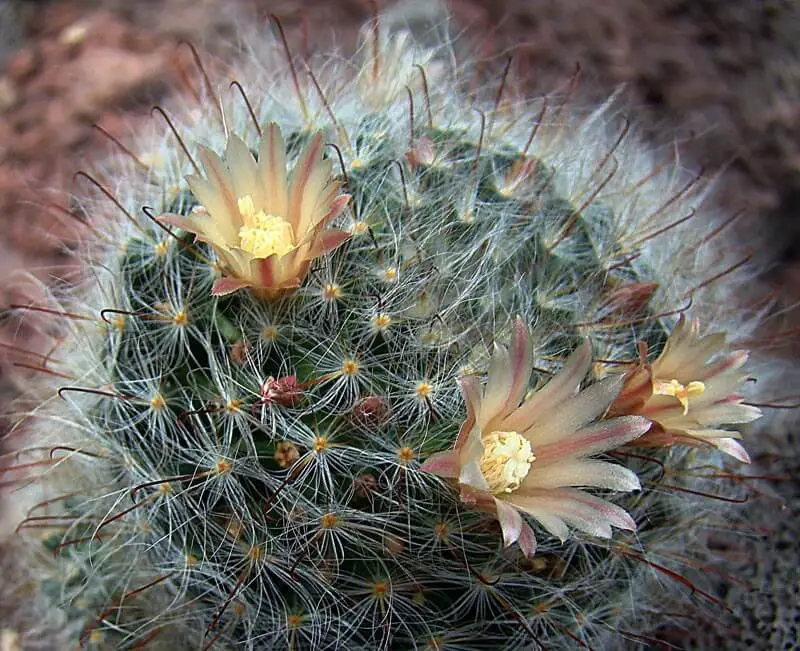
The powder puff cacti family is incredibly diverse, boasting an array of species that burst forth with vibrant flowers in the spring. These blooms are often likened to delicate crowns, adding a touch of elegance to any garden or windowsill setting. One of the most appealing aspects of these plants is their ease of cultivation and propagation. In fact, you’re likely to find powder puff cacti readily available at your local nursery or gardening store.
To coax the best growth from your powder puff, aim for well-draining soil with a gritty texture. This will mimic the plant’s natural habitat and promote healthy development. Another crucial factor in thriving cultivation is allowing the plant to experience a winter drought period. By withholding water during this time, you’ll be simulating the plant’s natural state and encouraging it to thrive.
Prickly Pear Cactus (Opuntia)
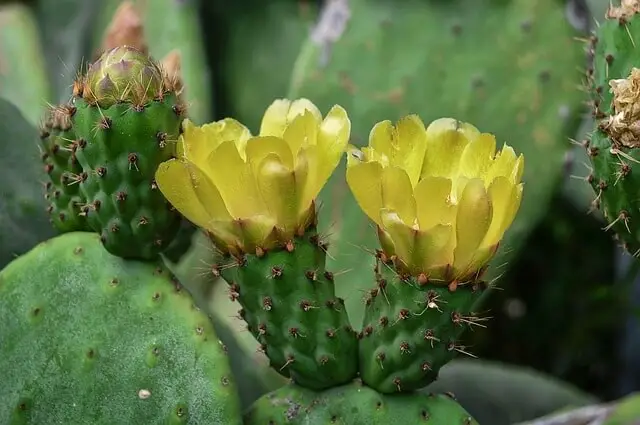
The prickly pear cactus is a dual blessing in the garden – its vibrant flowers are a feast for the eyes, while its edible fruits and pads offer a culinary delight. To reap this benefit, you’ll need to carefully remove the spines and peel the fruit, then incorporate it into your recipes. Just be mindful of those pesky spines and take steps to protect your skin. When it comes to growing conditions, prickly pear cacti thrive in environments with low humidity, ample sunshine, and warm temperatures.
It’s also important to avoid overwatering, as excessive moisture can leave them looking like sponges.
Rock Purslane (Calandrinia grandiflora)
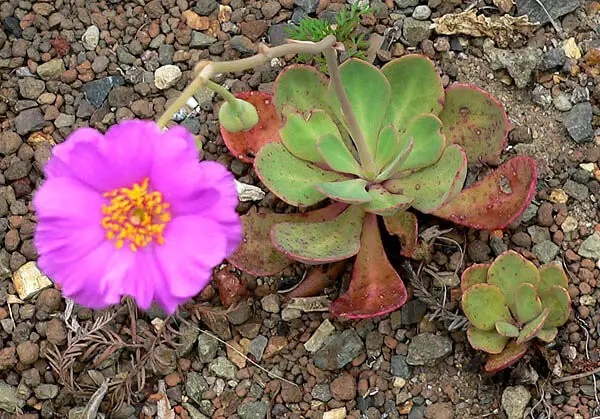
Rock purslane’s most striking feature is its stunning display of purple or pink flowers, often reminiscent of lavender. The blooming period brings a pop of color to your garden, and it’s not just you who’ll appreciate this beauty – bees and other insects are drawn to the sweet scents and vibrant hues. As an added bonus, rock purslane is low-maintenance and can thrive in warm, dry conditions with minimal watering required.
Its fragrant flowers even grow above the foliage, making them a delightful addition to your outdoor space.
Othonna capensis ‘Ruby Necklace’
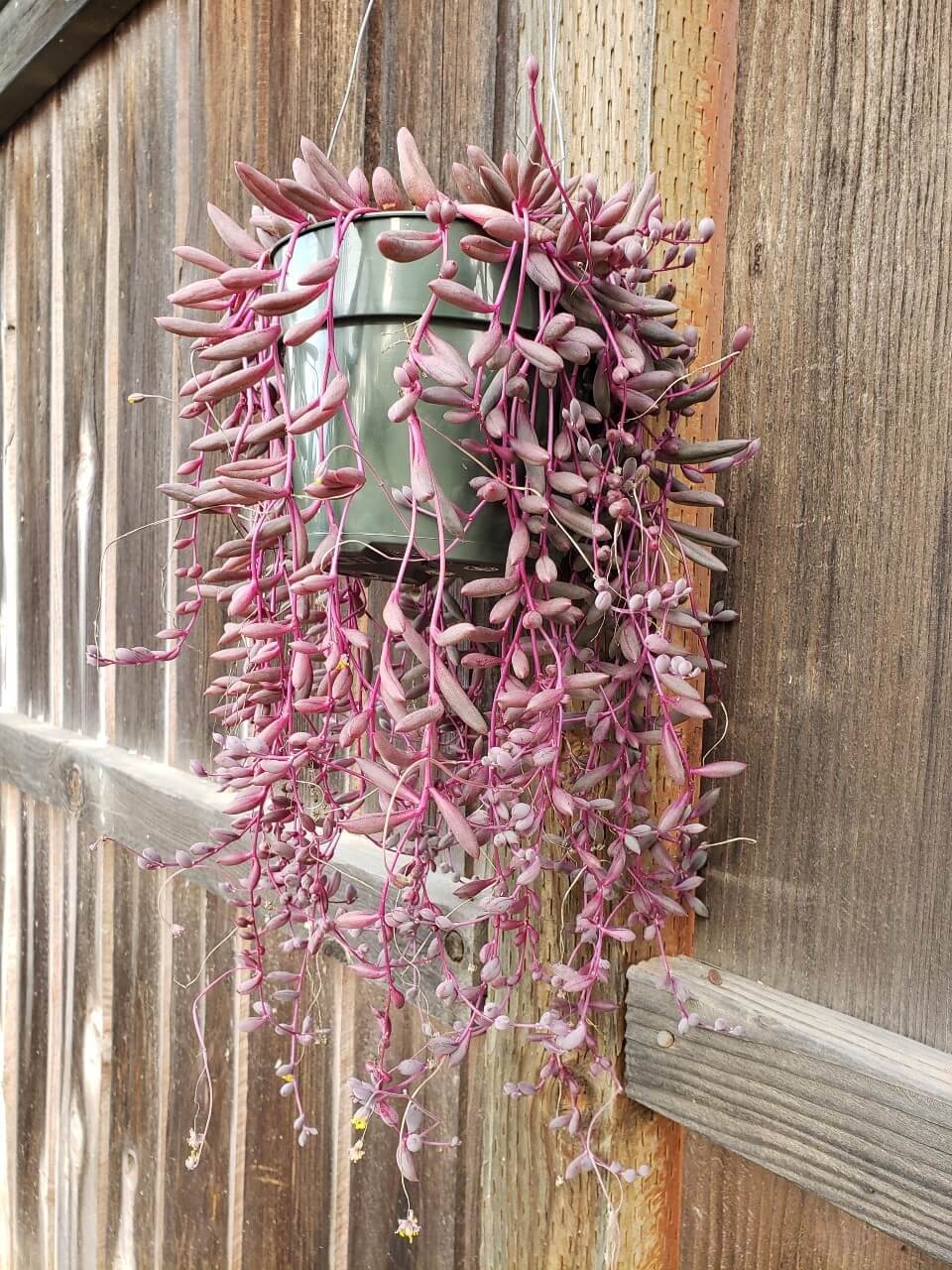
Ruby Necklace is a rapidly proliferating succulent that boasts an unique characteristic – the stem features bean-like foliage. Belonging to the daisy family, this stunning succulent thrives when grown in a hanging basket, showcasing its exceptional visual appeal.
The Ruby Necklace succulent boasts vibrant yellow flowers throughout the year, adding a pop of color to your garden.
Its green leaves take on a striking ruby red hue when exposed to sunlight, making it an eye-catching addition to any outdoor space. As with many succulents, Ruby Necklace requires consistent watering to maintain its beauty and ensure optimal growth.
Sedum (Stonecrop)
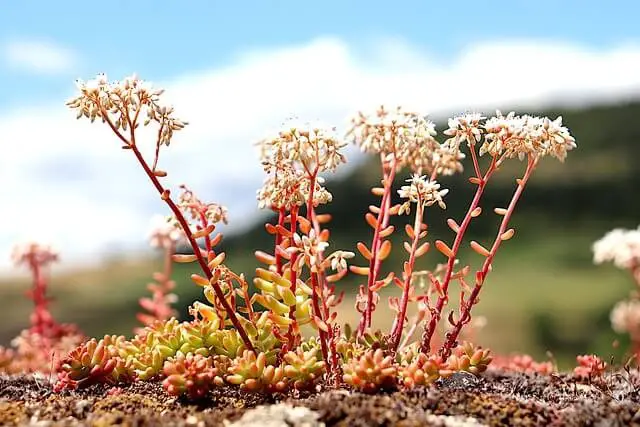
Despite their unassuming name, stonecrops are a vibrant and colorful addition to any garden. These plants produce a stunning array of blooms in shades ranging from bright blue to soft green, with hints of silver and pink thrown in for good measure. As the perfect ornamental choice for summer gardens, stonecrops bring a pop of color and whimsy to any outdoor space, making them an excellent addition to your garden’s flora.
String of Pearls (Curio rowleyanus)

Senecio Rowleanus, a succulent gem, has earned the admiration of many gardeners. Its trailing stems and delicate green pea-shaped leaves create a visually striking display when grown in hanging baskets. As summer approaches, the plant signals its arrival with an intriguing surprise: tiny white, fuzzy flowers that emit a sweet cinnamon-like fragrance.
Graptopetalum ‘Superbum’
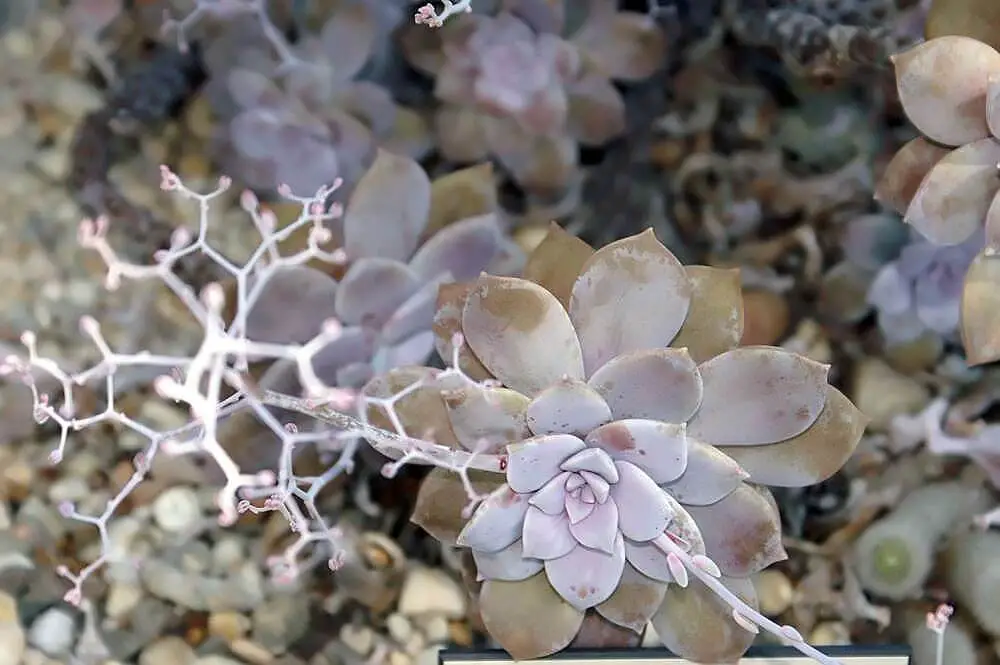
One of Superbum’s most notable characteristics is its low-maintenance nature. The plant produces star-shaped flowers in shades of white or yellow, typically blooming from late winter through spring. Its unique appearance, featuring purple-tinged leaves and bright yellow blooms, makes it a striking addition to any garden. Not only can Superbum thrive as a houseplant, but it also excels outdoors provided the temperature is warm enough.
During the summer months, regular watering is necessary, while in the winter, allowing the soil to dry slightly helps maintain the plant’s health.
Tacitus Bellus (Graptopetalum bellus)
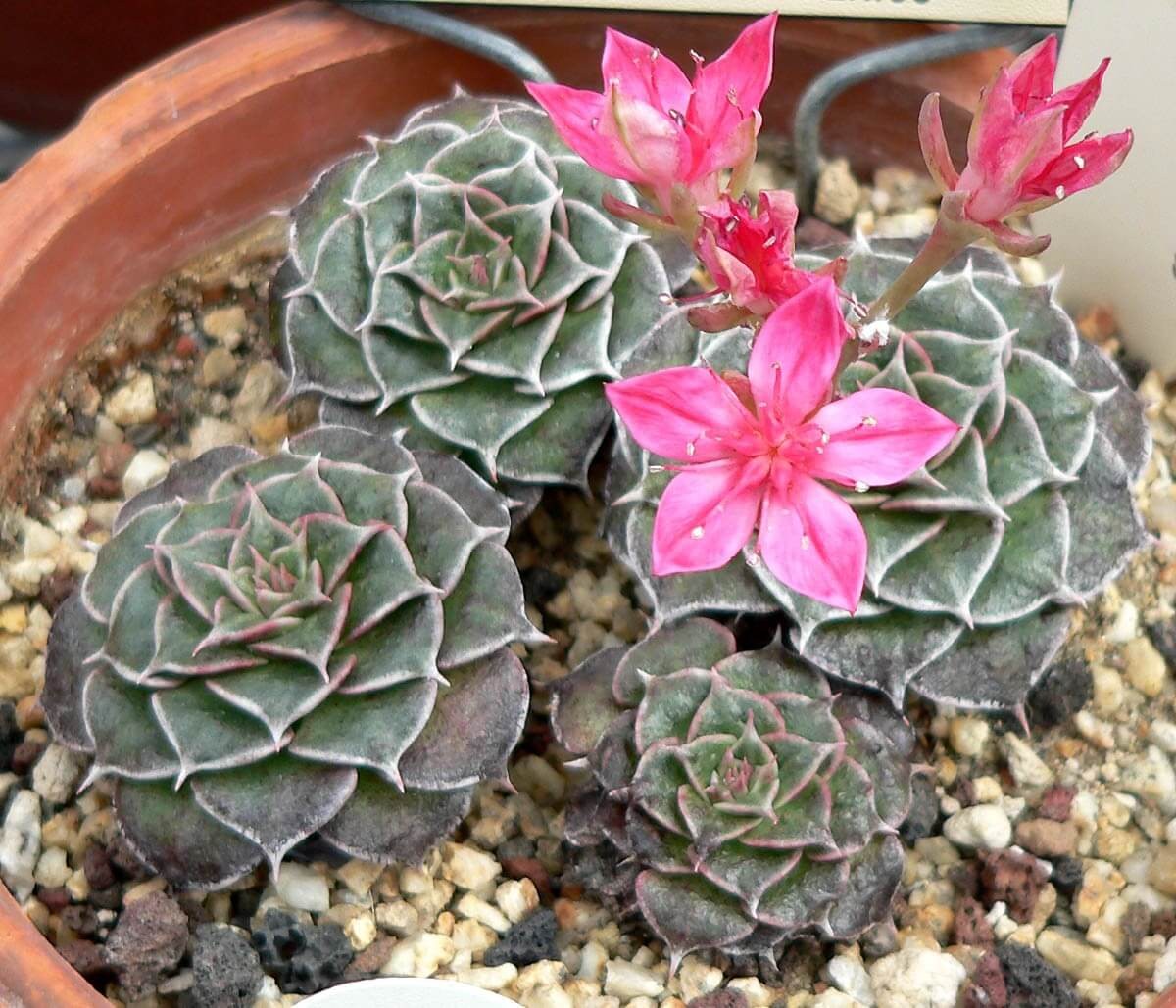
The star-shaped succulents are a stunning addition to any garden, boasting rosettes that can grow up to four inches in diameter. The vibrant flowers feature striking red stamens and dark pink petals, creating a breathtaking display. As the seasons transition from spring to early summer, you’ll be treated to an explosion of color as the blooms begin to unfurl. With proper care, these flowers can persist for several weeks, bringing joy and vibrancy to your outdoor space.
To encourage this long-lasting beauty, provide partial shade and ensure the soil retains its moisture – a gentle touch with watering is all that’s needed.
Conclusion
If you’re looking for a low-maintenance way to add some vibrant color to your garden, flowering succulents are an excellent choice. Not only do they thrive with minimal care, but they also come in a variety of types that can bloom at different times throughout the year, ensuring your outdoor space remains visually appealing 12 months round. As you enjoy their beauty, don’t forget to snap some photos and share them – it’s always more fun to appreciate nature’s wonders with friends!
Related Posts
When succulent enthusiasts notice their beloved plants begin to wilt and wither away, it’s natural to wonder what could be causing the decline. Is it a lack of watering? Too much sunlight? Perhaps something more sinister at play? As we delve into the world of succulent care, it’s essential to understand the common pitfalls that can lead to the demise of these charming plants.
In this realm, we’ll explore the intricacies of cultivating String of Pearls, Peperomia Graveolens ‘Ruby Glow’, Rhipsalis cereuscula (Coral Cactus), and even succulents in containers sans drainage, all while highlighting the unique characteristics of the fascinating Haworthia Fasciata (Zebra Plant, Zebra Haworthia). By gaining insight into these various species, we can better equip ourselves to provide the necessary care and attention required for our succulent friends to thrive.


